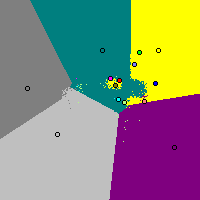
Slides for WDS lecture at Public Choice Society meeting Las Vegas NV 7 March 2009: /PCS09lecture.html
Thesis.
OLD (1999-2000):
"Bayesian Regret" (BR)
measurements indicated "range voting" was
the best single-winner voting method
among all commonly proposed alternatives.
If adopted instead of the currently most-used system, "plurality voting,"
humanity's lot should
improve by an amount comparable to or exceeding the
improvement got from switching from undemocratic forms of government to
democracy. [Crude (but conservative?) estimate:
each day delay getting range voting
costs (statistically) 5000 lives.]
NEW (2008):
Theory breakthroughs now allow, in certain
probabilistic models, evaluating BRs for numerous voting methods in closed form
and provably finding best voting methods (with minimum-possible BR).
Range voting is shown, in one model called
RNEM
("random normal elections model")
to have strictly lower BR than any rank-order-ballot based method, for any
mixture of honest and strategic voters, in 3-candidate elections.
Many other theorems and in some non-RNEM models too.
3-part paper amounts to 100 pages ⇒ can only partially
sketch the results and core underlying ideas.
Speaker is mathematician who co-founded CRV in 2005.
|
|

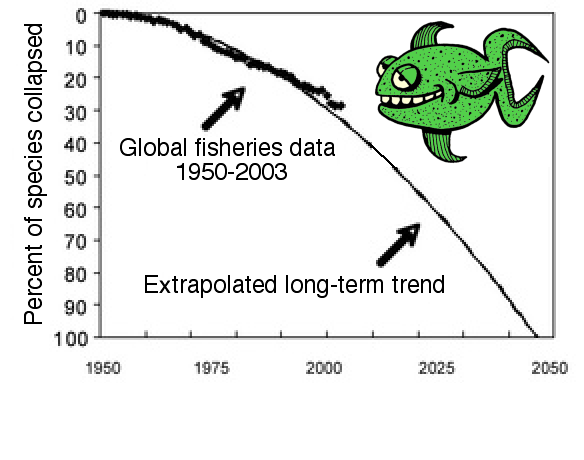
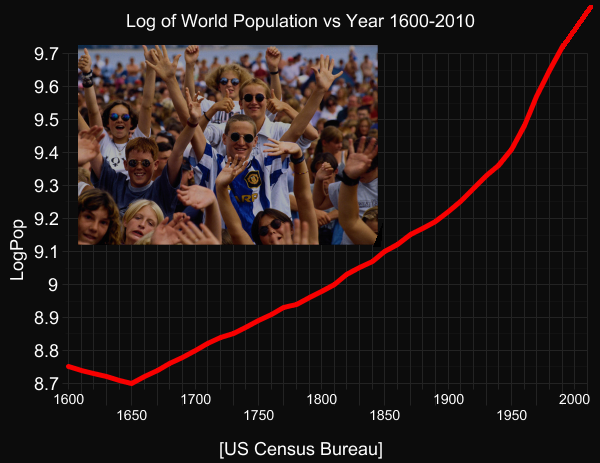
US now sole superpower ⇒
closest simple approximation to answer = USA's
appalling voting system. Features Bugs:
|
Systems most common in political science literature illustrated by example:
|
Plurality: A wins (most top-rank votes with 4).
Plurality+Runoff among top two: B wins over A in the runoff, 6-to-5.
Instant Runoff (IRV): C wins
(eliminate E, D, F, and B in that order – doesn't matter which way you break
DF tie – then C beats A in final round 7 to 4).
IRV repeatedly deletes the candidate with fewest
top-rank votes, then the remaining one wins.
Borda: D wins.
(D's Borda score is 16+9+4+5+2=36 versus E with 12+12+6+1+3=34 and
with lower scores for A, B, C, and F.) In the Borda system a candidate gets awarded
0 points if ranked last, 1 if ranked second-last, 2 if... and the candidate
with the greatest score-sum ("Borda count") wins.
Condorcet: E wins. (Since E pairwise-beats each other candidate, e.g. beating
A 6:5, B 6:5, C 7:4, D 6:5, and F 9:2.)
Approval Voting:
If all the red candidates are "approved," then F wins with
7 approvals (versus A=4, B=5, C=3, D=6, E=5).
And with 0-99 Range Voting, it would in fact be possible to make any of the 6 candidates win, depending on how the voters chose the scores compatibly with the orderings above. In Range Voting each voter awards a score from 0 to 99 to each candidate; greatest average score wins. (Fancier rules allow also scoring a candidate with X = intentional blank = "no opinion" – only numerical scores incorporated into averages.)
Another idea is median-based instead of ordinary average-based range voting.
K.J.Arrow's (1950) theorem states that no voting method can satisfy following short list of conditions:
|
Commonly heard: "Arrow's theorem shows that no 'best' voting system exists."
"Proof":
By Arrow, for every voting system, including the putative "best" system B,
exists an election which makes it look bad. Construct system A which looks good in that situation.
Then A is "superior" to B so B cannot be best. Q.E.D.


That all is wrong. Range voting satisfies all three criteria, accomplishing the "impossible"!
"Property based" thinking misled all of political science for 50 years.
No single-winner voting method exists (in which the votes are rank-order ballots) satisfying all of the following short list of conditions:
Extension: Furthermore, even if we allow nondeterministic voting methods in which chance plays a role, then the Gibbard-Satterthwaite theorem remains true except for this list of voting methods (which are the only probabilistic rank-order voting methods satisfying all the GS criteria):
Unfortunately, these voting methods are (in Gibbard's words) unacceptable because they "leave too much to chance."
Wait a minute. Doesn't Range voting (in the ≤3-candidate case) satisfy all GS criteria, accomplishing the "impossible"?!
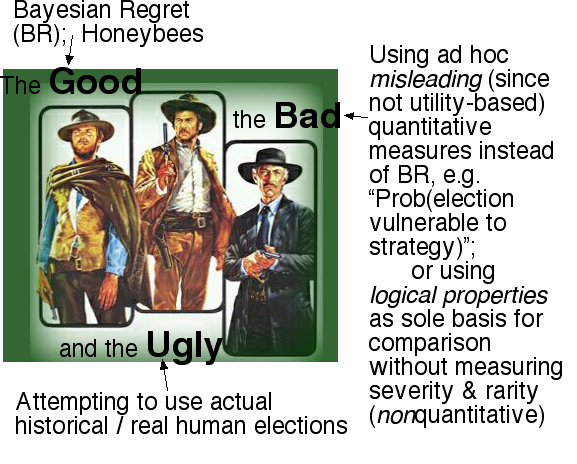
Oversimplified into nutshell: "Bayesian regret" of election method E is "expected avoidable human unhappiness" caused by using E.
More precise answer: Bayesian regret is gotten via this procedure:
Redo steps 1-6 zillion times (i.e. do zillion simulated elections) to find average Bayesian regret of election system E.
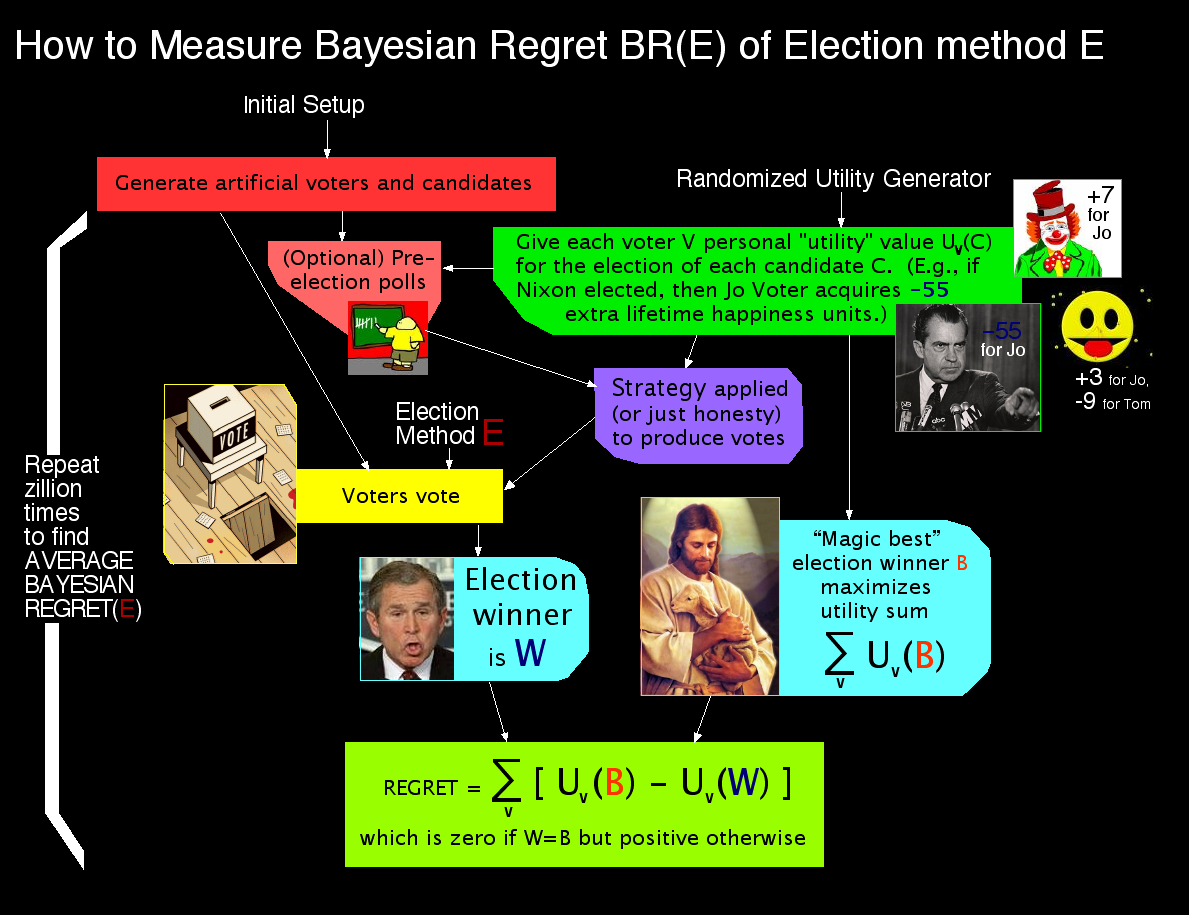
∃ at least 5 different "knobs" to "turn" on our machine for measuring Bayesian Regret of elctn method E:
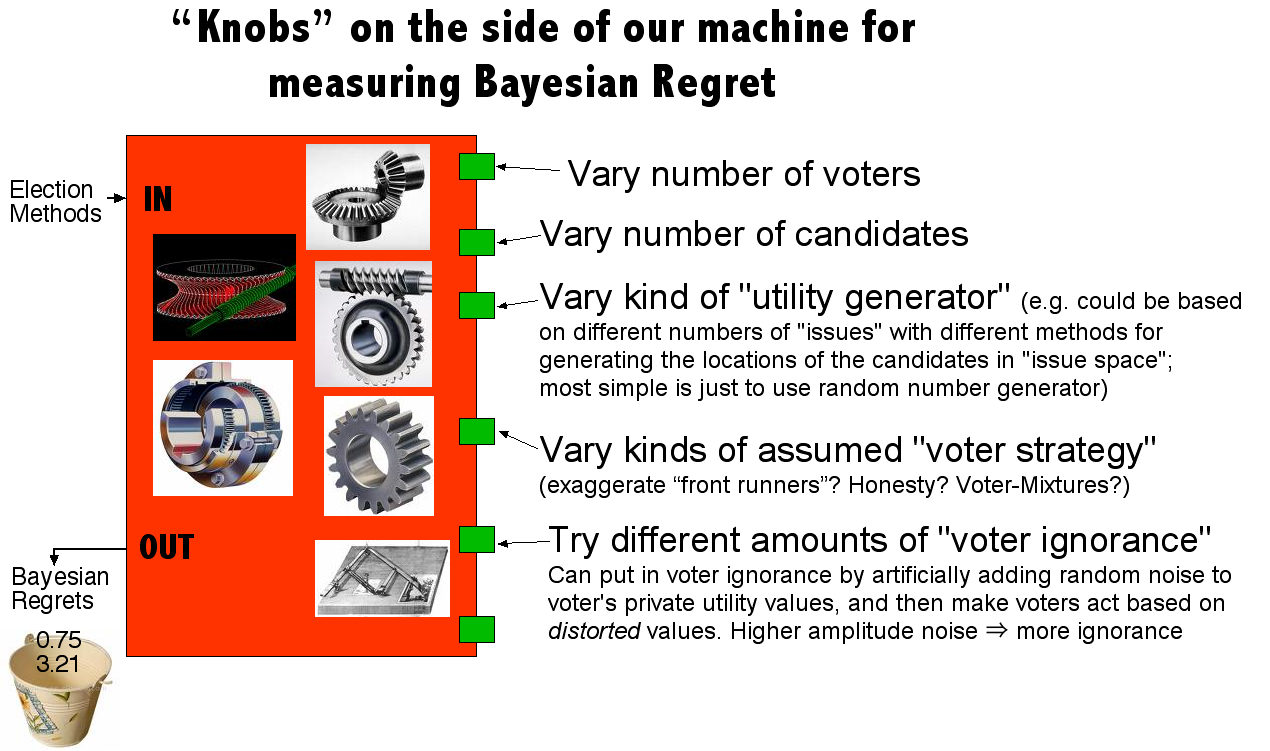
Measured Bayesian regrets for about 30 different election methods. 720 different "knob setting" combinations tried. Amazing result: in all 720 scenarios, range voting was best (had lowest Bayesian regret, up to statistically insignificant noise). We repeat: RV best in every single one of those 720 with either honest or strategic voters, regardless of ignorance-level, #candidates (3-5), #voters (5-200), #issues (0-∞) etc.
| Voting system | Regret A | Regret B |
|---|---|---|
| Magically elect optimum winner | 0 | 0 |
| Range (honest voters) | 0.04941 | 0.05368 |
| Borda (honest voters) | 0.13055 | 0.10079 |
| Approval (honest voters) | 0.20575 | 0.16549 |
| Condorcet-LR (honest voters) | 0.22247 | 0.14640 |
| IRV (honest voters) | 0.32314 | 0.23786 |
| Plurality (honest voters) | 0.48628 | 0.37884 |
| Range & Approval (strategic exaggerating voters) | 0.31554 | 0.23101 |
| Borda (strategic exaggerating voters) | 0.70219 | 0.48438 |
| Condorcet-LR (strategic exaggerating voters) | 0.86287 | 0.58958 |
| IRV (strategic exaggerating voters) | 0.91522 | 0.61072 |
| Plurality (strategic voters) | 0.91522 | 0.61072 |
| Elect random winner | 1.50218 | 1.00462 |
Warning: Table makes it appear Borda is second-best after range. But in fact the full study considers hundreds of tables like this, & in many of them, Borda is not second best, in fact in many it's way down in the rankings. The question of which system is second best has no clear answer – some better in some kinds of election situations, others in others.
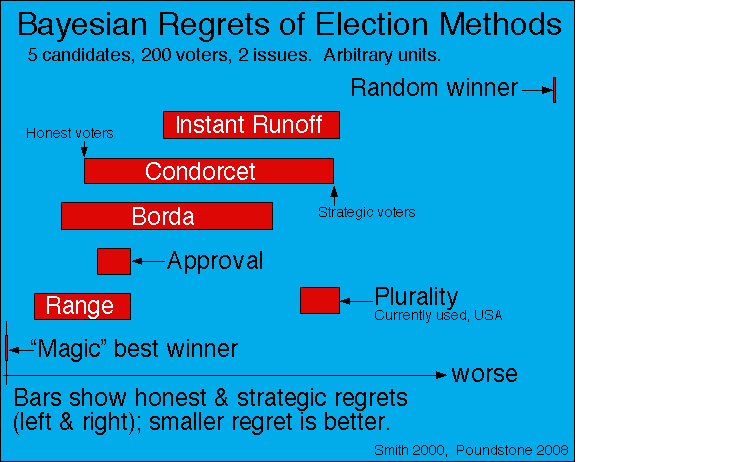
Less ambitious (but simpler and more reproducible) study: only did the "one-dimensional 3-candidate left-middle-right" political scenario, and very few kinds of voter strategy. But attempted exhaustive set of 623700 configurations, essentially completely covering that space.
Results (some surprises):
Number of voters = 23. Total number of scenarios = 623700. BetterCt[][]:
0 1 2 3 4 5 6 7 8 9 10
RANGE COND PLUR PKING RUNOFF BORDA APPROVAL APRNG WORST BEST RANDOM
0: 0 74096 140855 97481 95160 61600 89724 348 623603 0 623354
1: 23164 0 83007 27911 26539 19214 74446 22604 622834 0 619786
2: 19896 13239 0 22143 11271 32453 87685 19689 616431 0 581325
3: 22189 3246 58393 0 1197 22460 77692 21701 607990 0 597901
4: 22301 4606 60895 14571 0 23820 79052 21805 621036 0 603912
5: 23146 31692 114699 59603 58231 0 55232 22322 622674 0 619190
6: 23288 58942 141949 86853 85481 27250 0 22096 622426 0 602400
7: 1204 74380 141498 97833 95520 61620 89376 0 623606 0 623386
8: 0 0 0 0 0 0 0 0 0 0 0
9: 28918 79832 149525 103473 101767 67354 95336 28062 623700 0 623700
10: 328 3808 42130 25711 19664 4429 21094 296 623700 0 0
|
BR: 2.03 10.9 27.7 17.5 15.6 7.5 18.0 1.94 69.0 0 39.7 |
MY ESTIMATE: Each day delay getting Range voting ≈ 5500 deaths.
RV=comparable improvement over democracy as invention of democracy. Both transitions non-democracy(modeled by "random winner" or better) → democracy(strategic plurality voting) → Range Voting (halfway between honest & strategic BR numbers) comparable in terms of BR reduction; if anything second looks larger. So: How important is democracy?
1. Democide: Governments killing own people for ethnic, racial, tribal, religious, or political reasons.
2. Government waste: Economist M.Bailey estimates US Govt spending is 50% waste (e.g. same power military could be got with half the money, etc.); detailed tabulation in his book.
3. Life expectancy & GNP/capita: both significantly higher (on average) in democracies. (E.g: [a] Life expectancy in E.Germany jumped 6 years since reunification; [b] Taiwan 77.4 vs China 71 also 6 years; [c] Compare North & South Korea; [d] check Vanhanen's & Barro's large cross-country datasets and fits.)
4. Save world via better decisions? Suppose USA, by adopting range voting, lowers risk of 2-billion population crash in 50 years, by 5%. That's 5500 lives/day.
5. Better economic growth? USA 20× richer than Pakistan per capita. But 300 years ago, about same. Vast disparity is result of 1% faster economic growth.
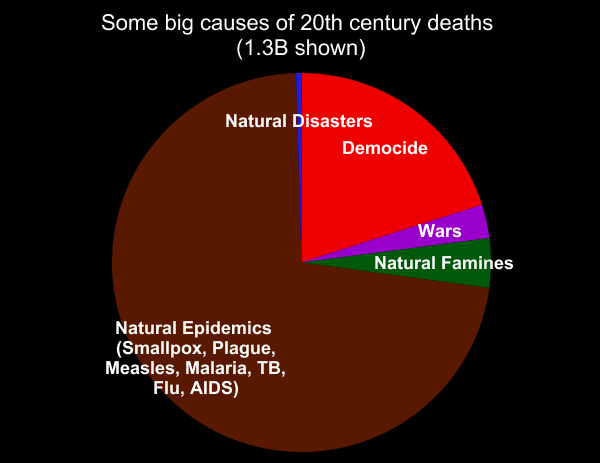
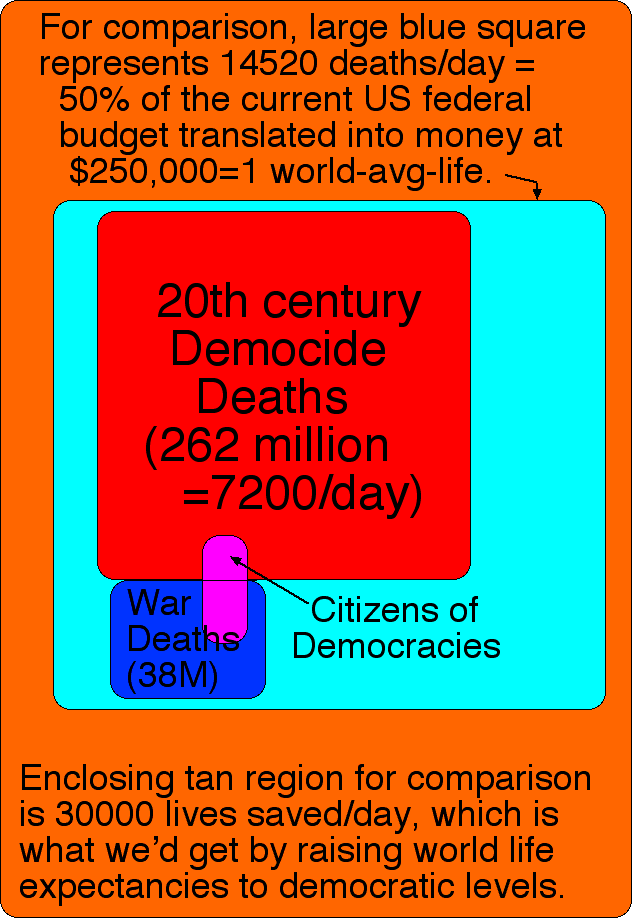
Range voting gives you more "bang" for your buck than almost any other philanthropic option. Maybe the most lives saved for this small an effort. And you can be in the steep part of the learning curve by seeding the start of the RV movement, getting huge leverage for your money. (More details)
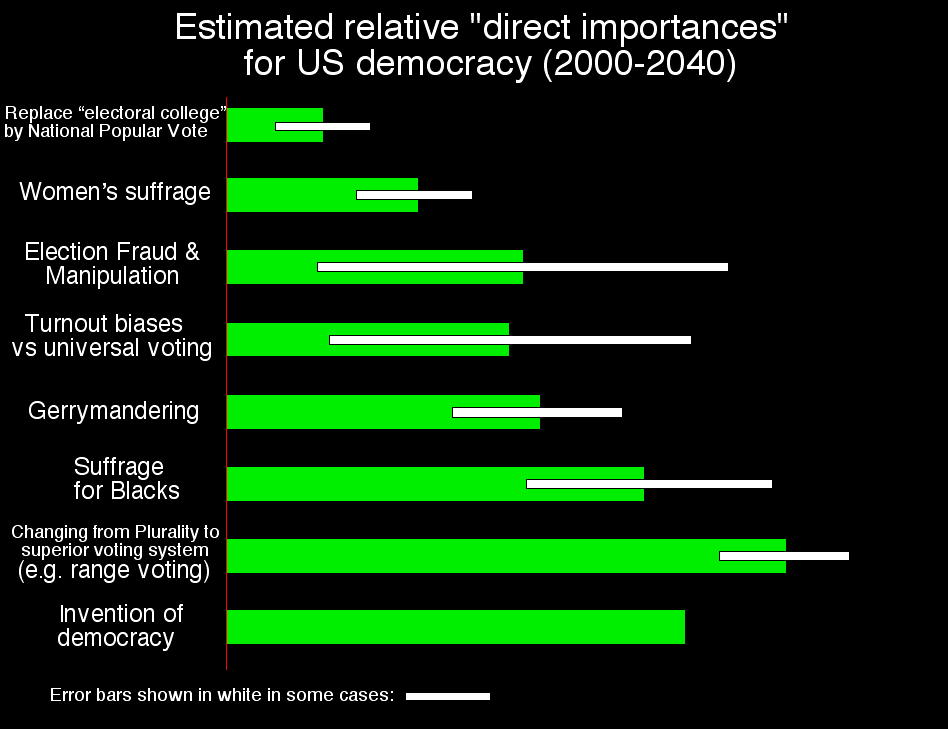
Techniques behind this: Bayesian regrets, estimates of what fraction of elections and votes each item would swing. (Half as much ⇒ half as "important.") Techniques can be grounded in something "rigorous" either as a generalized "voting power" or using "small perturbation" models.
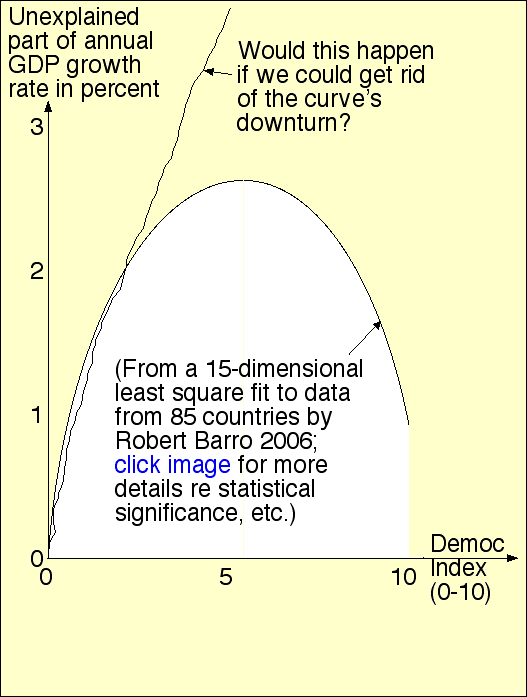
Book R.J.Barro: Determinants of Economic Growth: A Cross-Country Empirical Study predicts growth rate of country's real GDP from facts about country. GDP growth enhanced by:
But democracy increases GDP in peculiar way (pictured): increases in Barro's political rights index from 0 to 5.6 on a scale of 0-10 (yielding a moderate level of freedom and democracy) increased GDP growth rates additively by 2.6% but a further increase in the index from 5.6 to 10 retarded growth by negative 1.6%.
All of Barro's causative factors (listed) cause approximately equal additive effects on predicted real-GDP-growth-rate, namely about 2-5% each. That is, having the optimum level 5.6 of political rights causes about 2.6% higher (additively) annual GDP growth rate than the pessimal level 0; countries about one standard deviation above usual in education levels are predicted to have about 3% higher than usual annual-GDP-growth; etc.
Correlation≠certainty so democracy does not force a good economy. E.g, China doing better than India.
Barro ideologically tries to explain by postulating: more democracy ⇒ more government income redistribution ⇒ hurts growth. But attackable because Barro's fit already had incorporated government expenditures as different predictor; democratization was only being fit to unexplained part of the GDP growth above and beyond that explainable as result of government outlays. Barro partly defends by saying that government transfer payments were not held constant. But, assuming Barro has idea that transfers aim toward equalizing wealth, he is exactly wrong about its economic effect: the Deininger-Squires 1998 World Bank cross-country study found that greater initial inequality is strongly negatively correlated to future economic growth!
In other words, the "trickle down theory" often associated with Ronald Reagan is wrong. According to George R. G. Clarke: More Evidence on Income Distribution and Growth, J. Development Economics 47,2 (Aug. 1995) 403-427, "This conclusion is robust across different inequality measures, and to many different specifications of the growth regression. Furthermore, inequality appears to have a negative effect on both democracies and non-democracies. Interaction terms between inequality and regime type, when included in the base regression, do not affect the sign or significance of [this]." So this seems to settle the matter. (However, to completely clarify matters, it would be good to put transfer payments into Barro's fit also, to see what happens. And two other good predictors to try inserting would be a country's winter temperature and the "centralization fraction" of its government [See A.Lijphart: Democracies 1984 table 10.2 page 178].)
Two other possible explanatory hypotheses: (more supported than Barro's):
There's also psychological reasons, tactical reasons, and "secondary effects"...
Let's look into all these in a little more depth...
Avoids favorite betrayal: In range voting, there is never a strategic reason to give your favorite a non-top score. (Unlike: IRV, Condorcet, Borda, Plurality, where favorite-betrayal often advisable.)
Semi-honesty: In range voting, if you know all other votes (or in a ≤3-candidate election even if you have only partial knowledge of the other votes), then there is always a strategically-optimal "semi-honest" threshold-style vote, where create a "threshold" T and give all candidates better than T score=99, all others score=0. (Unlike: IRV, Condorcet, Borda, Plurality, where it can happen that every honest & semi-honest vote is non-strategic.)
Pleasant surprise theorem: Suppose each voter chooses T=their expectation of the value of the winner. Then: the range-winner will maximize the number of voters who are "pleasantly surprised" (result exceeds expectations). That's an optimality property related to, but not identical to, minimizing Bayesian regret.
Range⇒Condorcet theorem: Suppose each chooses T somewhere between candidates C and A, where C and A are viewed as the two most likely to win. If one of C or A is an honest-voter Condorcet winner, then he will also be the range-winner. (Suggests that in practice, Condorcet cannot have much advantage over range.)
Why? Strategy. Don't want to "waste vote." (⇒ all previous BR studies, with only "honest voters," are of little interest. Also all previous left out Range Voting)
|
19-voter example illustrating "Favorite Betrayal" & "Condorcet cycle." B wins under vast variety of rank-order election methods (e.g. Borda, Condorcet-LR, IRV).
But if the six N>G>B voters insincerely switch to G>N>B ("betraying their favorite" N) then their "lesser evil" G becomes the winner under all those voting systems – in their view a better election result.
This favorite-betrayal example very important because, once voters understand exaggerating their stances on the apparent-frontrunners can be necessary to prevent "greater evil"s victory, strategic voting is guaranteed, often causing "third parties" to tend to die out (since the strategic voters won't "waste their vote" on honest-favorite third-party candidates like N whom they perceive as having "no chance of winning").
Range Voting: Favorite-betrayal never strategically forced.
|
100-voter example election illustrates: old controversy between Borda and Condorcet (France ≈1780):
|
Condorcet: A should win. (A also wins under IRV voting method.) Borda: no, B should win! Who really should win? Good question.
How would range voting handle this? RV allows voters to say how much they prefer B over A (or whoever). Quantitatively. Really, Borda or Condorcet are both right – but depending on intensity-of-preference information unavailable to their voting methods, but available to range voting. So this example illustrates an advantage of range voting over both previous voting systems.
|
|
|
A 5-voter example. Borda totals: A=9, B=8, C=7, D=6. Reversed Approval counts: A=1, B=2, C=3, D=4! (Generalizes to N candidates.) Both Borda and Approval clueless; range voting (with extra intensity info) can do something sensible.
Several near-identical "clone" candidates run. Plurality voting: they split the vote and all lose. The very popularity of a view can cause its defeat! Borda voting (basically): enough clones ⇒ opposite effect ("teaming"); assured victory!
|
|
Cloning the Bores ⇒ huge advantage! Boring party can just arrange for mucho Bores to enter the race & totally Boring! Of course, Mushites could try to defeat that by intentionally lying in their votes by ranking Bores in opposite of true order, to try to cancel out the Borites and make Mush win. But this strategy causes them to be massively dishonest in their votes and risk not only a Bore-victory, but in fact a victory by the worst of the Bores! (Which would in fact happen if the Borons counterstrategized by also being dishonest in their Bore-orderings!) Crazy!
Mushites: fight by nominating own clones, Mush1, Mush2, Mush3, and Mush4, so they'll win. Bores: countersponsor more clones Bore4, Bore5, Bore6. Etc. War of clone armies. All about gall, little to do with what voters actually want.
Has caused parties to intentionally aid opponents of their point of view ("helping a spoiler")! And it also has (more often) caused parties to intentionally hurt allies of their point of view!
Range Voting: clones & "vote splitting" don't matter, election result not affected. Can't manipulate the election by creating or abolishing clones.
4 candidates and 7 voters. Start looking at situation on left.
|
|
Range Voting: Removing a loser (from all ballots & the election) never changes anything.
Common scenario: Whenever there are 3 rival contenders A,B,C plus one or more "dark horses" D we all agree are worthless no-hopers: In Borda & most Condorcet systems it pays for each for the 3 factions to dishonestly rank D "above" the other two rivals. (Strategic justification: Whichever faction votes honestly, guaranteed to lose the election. Condorcet systems with equal rankings allowed? Ranking D co-equal-last like A>B=C=D is not good enough strategy; only "full force" dishonesty A>D>B>C is strategic.)
|
|
But – Worst possible disaster result: if enough voters do that, D wins.
(DH3 resembles "spoiler pathology" & game of "chicken."
But it's worse. And probably more common.)
Range, IRV, plurality: immune to DH3.
| #voters | their vote |
|---|---|
| 28 | A>B>C>D |
| 25 | B>C>D>A |
| 24 | C>D>B>A |
| 23 | D>C>B>A |
A would lose to any opponent in head-to-head election by 72-to-28 margin, and is ranked dead last by 72% of the voters.
But plurality elects A with 28% of the vote (28>25).
is the property of a voting system that both
Unfortunately, Instant Runoff Voting (IRV) is not monotonic; fails both criteria.
|
Criterion I fails: when two voters change their vote to C, that stops C from winning. Details: C wins this 17-voter IRV election (B is eliminated and 1 more of his 5 votes transfer to C than to A, causing C to win 9:8 over A). But after the two A>C>B voters instead give their vote to C, then B wins. (In the new election, A is eliminated and his 4 votes transfer to B, causing B to win 9:8 over C.) This occurred in the Louisiana 1991 governor election, which was a (non-instant) runoff election with 12 candidates but only the top 3 got over 410,000 votes each; the remaining 9 candidates each got under 83,000 individually and under 125,000 in the aggregate. |
| ||||||||||||
|
Criterion II fails: when two voters change their vote away from B, that causes B to win. Details: C wins this 17-voter IRV election (A is eliminated and his 4 votes transfer to C so that C wins 9:8 over B). But after 2 of the B>A>C voters instead give their vote to A, then B wins. (In the new election, C is eliminated and his votes transfer to B so that B wins 11:6 over A.) This occurred in (an altered form, with extra Currie voters added, of) the Irish 1990 presidential election, which was an IRV election with 3 candidates. |
|
More.
|
1. In this 24-voter IRV election, A wins after C is dropped. But now suppose every voter reverses his preference order (now attempting to choose worst rather than best). In that case A still wins after B is eliminated. I.e. IRV contradicts itself; IRV's unambiguously "best" candidate A is here the same as its "worst"!
|
Also illustrates bizarre kind of strategic voting: Suppose 3 of the B>C>A voters reverse their votes to A>C>B (or alter them to A>B>C; that also works). Then B is eliminated whereupon C wins 13-to-11 over A. The raising of A from bottom-to-top in their vote caused A to lose – and voting maximally dishonestly as though they were suicidally trying to elect the worst candidate, was actually optimal strategy!
2. Also illustrates "no show paradox": If those three B>C>A voters had simply refused to vote, then C would have won (an improvement in their view). Different way of saying the same thing: these three voters' decision to cast an honest A-last vote caused A to win.
Thus IRV violates participation property: Honest voter, by participating, should not worsen election result (in her view). I.e, "abstaining is not a better strategy than voting."
There is no such thing as a district "subtotal" anymore if we use IRV voting. Example:
|
|
In district I, IRV eliminates C, then B wins 7:6. In district II (same as district I but the roles of A and C are reversed), B also wins 7:6. But in the combined 2-district country, B has 8 top-rank votes, A and C have 9 each, so B is eliminated and either A or C wins. Thus merging two districts both won by Bush under IRV, can produce an IRV victory for Gore.
Fraud prevention: I want precinct totals to be published. That's not going to happen if a precinct is going to have to publish 6!=720 "totals" in one race. (And even if that did happen, then this publishing would defeat ballot secrecy and open the door to vote-selling and coercion.)
(More; analogous problem for Condorcet voting systems)
Computers⇒new kinds of election fraud. Many people think best to forbid computers. Use "dumb" (mechanical, noncomputerized) machines.
Mathematically: ∃ transformation of one C-candidate (0-9 plus X) range voting election to 11C artificial "plurality elections." In some cases, this is easy and convenient from the viewpoint of voters (optical scan machines) in others it is less convenient (which is why we would prefer to have purpose-designed range-voting machines) – but it always works, easing transition worries greatly.
Demo:Award each candidate a numerical score from 0 to 9. Advise giving your favorite candidate 9 and the worst one 0. If you intentionally wish to express no opinion about that candidate, then please do not select any score for him – equivalently leave the default "X" choice selected; only numerical scores will be incorporated into the averaging.
Also try zohopolls, SuperDuperApps, or this instant runoff demo (IRV will not run on many of today's voting machines).
Here's an interesting hypothetical election to keep in mind when considering the risk of ties under IRV (Instant Runoff Voting).
| %Voters | Their vote |
|---|---|
| 50 | Kiss > Miller > Curley |
| 25 | Curley > Miller > Kiss |
| 25 | Miller > Curley > Kiss |
With plain plurality voting, Kiss wins in a landslide and there's no recount called for.
With IRV Miller and Curley are nearly tied, and so all kinds of recount lawsuit nonsense ensues. Then the winner of that battle goes against Kiss, and then he and Kiss are nearly tied and so another series of lawsuits ensues.
More. IRV "exponential amplification".
| Voting system | Favors Centrists or Extremists? | |
|---|---|---|
| Plurality | Extremists |  |
| Approval | Centrists or no bias (depends on assumed voter "thresholding" behavior); also if they vote "plurality style" will duplicate plur's extremist-favortism | |
| Condorcet Rank-order systems | no bias |  |
| Borda Rank-order; Range | little or no bias (pictures = slightly distorted version of above) | |
| Instant Runoff (IRV) | Extremists |  |
Here's two pictures (by Ka-Ping Yee himself!) comparing Condorcet & IRV:
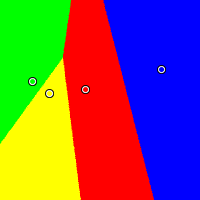
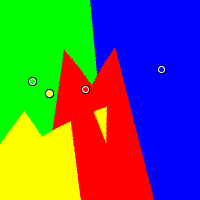
Condorcet's idea: a winner should beat every rival pairwise. (Unfortunately there can be a cycle and then no CW exists.)
| #voters | Their Vote |
|---|---|
| 51 | A>B>C |
| 49 | B>C>A |
This 100-voter example election illustrates an old controversy between Borda (1733-1799) and Condorcet (1743-1794). According to Condorcet, A should win. (Here A also wins under the IRV voting method.) But according to Borda, B should win. Who really should win? Good question.
Now let's see how range voting would handle this. If the voters say
| #voters | Their Vote |
|---|---|
| 51 | A=99, B=70, C=60 |
| 49 | B=95, C=90, A=85 |
| Average | A=92.14, B=82.25, C=74.70 |
then A wins. But if they say
| #voters | Their Vote |
|---|---|
| 51 | A=99, B=95, C=40 |
| 49 | B=90, C=85, A=40 |
| Average | A=70.09, B=92.55, C=62.05 |
then B is the winner.
The point is that range voting allows voters to say how much they prefer B over A (or whoever).
Classic over-simplified and over-dramatized example is the "kill the Jews" vote with choices
------------Leftist-------------Centrist--------------Rightist---------------
35 32 33
In this 3-candidate election, Leftist voters prefer Centrist>Rightist and Rightist voters prefer Centrist>Leftist. Result: Centrist is (huge) "Condorcet winner" defeating each rival pairwise by 65:35 or larger majority.
But Instant Runoff Voting (IRV) eliminates Centrist immediately. This happened in e.g. Peru 2006.
"When all but two candidates (X & Y) are removed from all ballots then X defeats Y, we say X "pairwise" defeats Y. Condorcet demands that a candidate who pairwise defeats every rival must win the election."
Wait: According to this wording, range voting is a Condorcet method!
(BUT: According to the usual view, range is not a Condorcet method because, e.g, one voter could have hugely-strong preferences outweighing a lot of voters all with very weak preferences. In such case, no reason majority will win.)
| Voting system | Expressive | Participation | Favorite- Safe |
Clone- Safe |
Monotonic | Remove- Loser- Safe |
Precinct- Countable |
Dumb- Machines |
Extremist/ Centrist Bias |
Simplicity |
|---|---|---|---|---|---|---|---|---|---|---|
| Plurality | The Worst | yes | FAILS! | FAILS! | yes | FAILS! | yes | yes | Extremist | good |
| Approval |  or or  on each canddt |
yes | yes | partial | yes | yes | yes | yes | voter- behavior- dependent |
best (excellent for meetings) |
| Condorcet systems | rank order | FAILS! (2.5%?) | FAILS! | yes & no | yes & no | FAILS! 9% | yes & no | FAILS! | unbiased | complex |
| Borda | rank order | yes | FAILS! | FAILS! | yes | FAILS! | yes | FAILS! | ok | medium |
| Instant Runoff (IRV) | rank order | FAILS! 16.2% | FAILS! 19.6-100% |
yes | FAILS! 14.7% |
FAILS! | FAILS! | FAILS! | Extremist | complex |
| Range | The Best | yes (if no "blanks") | yes | yes | yes | yes | yes | surprisingly yes | ok (bias, if any, small) | surprisingly good |
Expressiveness: The more kinds of votes you can cast, the more expressivity you have. With plurality voting in an N-candidate election, you have N possible votes (or N+1 if "not voting" is allowed and we count it as an additional option). That is a lot less expressivity than approval voting with 2N possible votes. With rank-order voting systems you have N! and with 0-99 range voting you have 100N (or 101N if "no opinion" scores permitted for each candidate).
Participation: If casting an honest vote can never cause the election result to get worse (in that voter's view) than if she hadn't voted at all, then that voting system satisfies the "participation property." (Some voting systems like Condorcet and IRV fail this – they exhibit "no-show paradox" elections where some class of voters would have been better off "not showing up.")
Favorite-safe: If it never is more strategic to vote a non-favorite ahead of your favorite, then the voting system is "favorite-safe." (So-called because it is "safe" to vote for your favorite.)
Clone-safe: If a "clone" of a candidate (rated almost identical to the original by every voter) enters or leaves the race, that should not affect the winner (aside from possible replacement by a clone). We call voting systems obeying this "clone-safe." Borda and plurality voting severely fail this property.
Monotonicity is the property of a voting system that
Remove-loser safe: If some losing candidate X is found to be a criminal and ineligible to run, then the same ballots should still be usable to conduct an election with X removed, and should still elect the same winner. (But if X's departure changes the winner, the property fails. In several voting systems, e.g. Borda, X's departure can actually reverse the finish-order of all the other candidates, a dramatic failure.)
Precinct-countable: If each precinct can publish a succinct summary of the vote (sub)total in that precinct, and the overall country-wide winner can be determined from those precinct subtotals, then the voting system is "precinct-countable."
Dumb machines: Are "dumb" (i.e. non-computerized) totalizing voting machines, designed only to support plurality voting, usable for this voting system?
Extremist/Centrist bias: Suppose the candidates are positioned along a line (1-dimensional) or in a plane (2-dimensional) and voters prefer candidates located nearer to them. In some voting systems, it is usually difficult or impossible for "centrists" (centrally located relative to the other candidates) to win. Those systems "favor extremists." Other voting systems "favor centrists." We apologize for defining this property rather vaguely, but in practice it is often quite clear which category a voting system belongs in. For example, see these pictures (especially "note #2") to see that Instant Runoff (IRV) voting favors extremists.
Simplicity: Voting systems with simpler rules, simpler counting algorithms, and found to be simpler by human voters are "simpler." If you want to be precise about this, then we point out you can objectively measure the "simplicity" of the rules and vote-counting algorithm as the length of the shortest computer program that inputs, checks-validity-of, and counts the votes to determine the winner. And you can objectively measure how simple humans find it to vote by e.g, comparing ballot spoilage rates under different voting systems, or comparing the average time it takes humans to cast their vote or for other humans (or computers) to count them.
"Primary" effect (reckoned using Bayesian regret) = just who wins the election & how much utility that is. "Secondary" effects exert themselves over historical time in sequence of many elections. When these also reckoned, RV looks even better...
2-party domination: In systems where "favorite betrayal" common enough, "2-party domination" happens (third parties die out). 2PD quickly became massive (>99.5%) in the USA (plurality voting) since "idiotic to waste vote by voting Nader." 2PD also experimentally has always happened under IRV, despite moronic propaganda (Australia, Ireland, Fiji). 2PD has not happened under plur+top-2-runoff. ("Duverger's laws.") 2PD might happen under Condorcet systems.
Consequent diminution of voter choice:
One-party domination: 98% predictability in contemporary USA. (One reason is gerrymandering... by which one party can stay permanently in power even if only 25+ε% support.)
Cash: is extremely important in plurality voting, but perceived to be less so in other systems e.g. plur+top-2-runoff. Why? Need to demonstrate you are one of the top-2 "frontrunners," i.e. create illusion of winnability, otherwise not worth wasting vote on you. That's expensive. (Educating about issues: cheap.)less
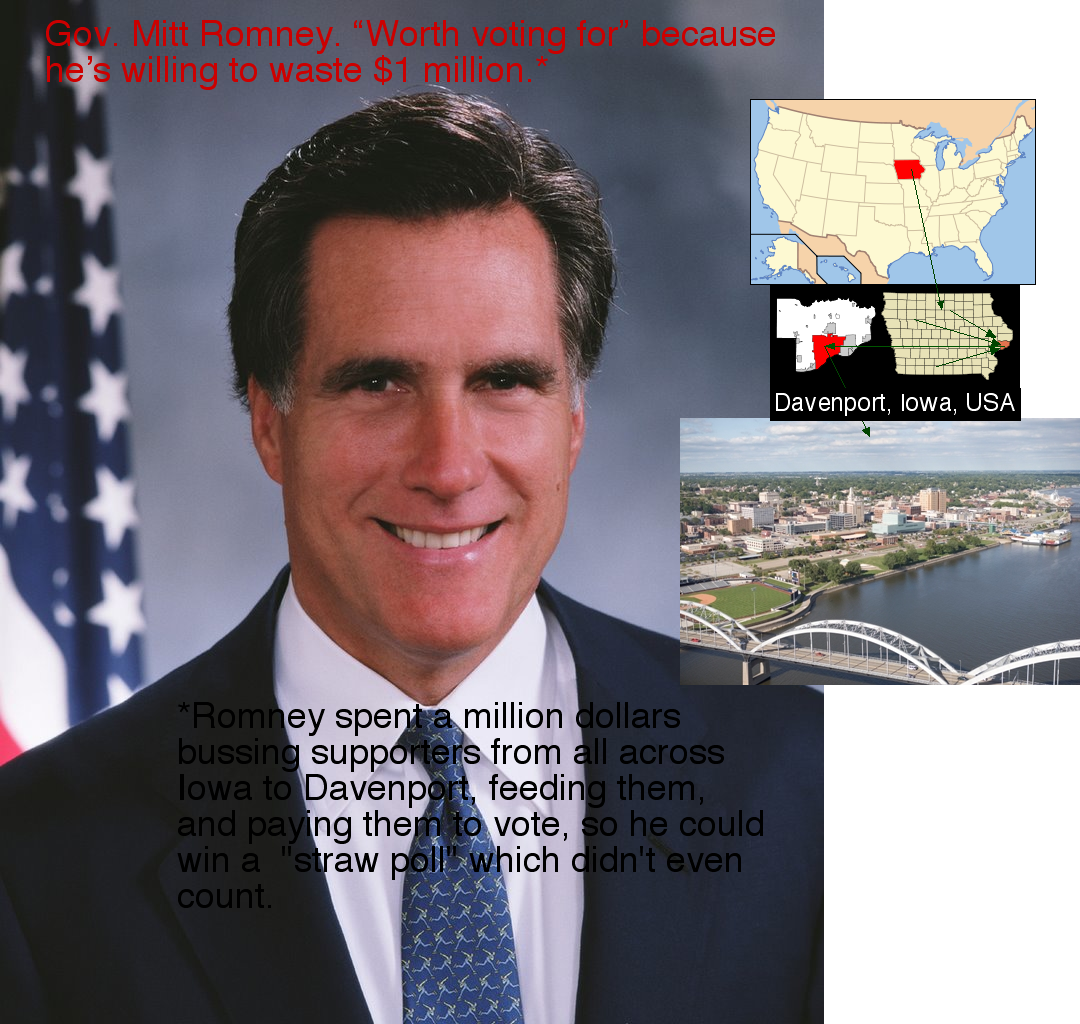
Media: Pays no attention to third-party views (no motivation; they're not news). Media "lapdogs" unquestioningly accept politicians' BS without much critical examination (because with 2-party and 1-party domination, politicians are in monopoly position to cut off media lifeblood; with multiparties no such info monopoly). Much more interested in the "horse race" than the issues.
Lack of congressional oversight: For most of about 8 years, Democrats in Congress haven't been able to subpoena anyone.
Rubberstamped agency heads & judge appointments: In votes for court of appeals nominees, Republican Senators during the Bush administration (during majority control) produced 2703 votes for the nominee as opposed to only a single "no" vote (cast by Trent Lott against judge Roger Gregory, the first Black ever appointed to this position).
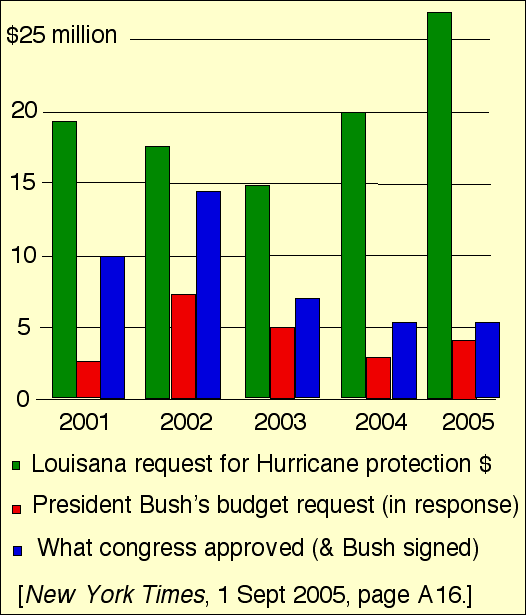
Bush appointed Joseph Allbaugh as head of FEMA in 2001, although Allbaugh had no expertise or experience handling emergencies, but rather had been then-Texas-Governor Bush's chief of staff & campaign manager for Bush-Cheney nationwide campaign. (Allbaugh had B.S. in political science from Oklahoma State University.) In 2003, Allbaugh replaced by Michael D. Brown – Former estate and family lawyer and bar examiner. The Boston Herald reports that Brown was "fired from his last private-sector job, overseeing horse shows... after a spate of lawsuits over alleged supervision failures... `He was asked to resign,' Bill Pennington, president of the IAHA at the time, confirmed last night."
Pork & earmark game-playing:
FEMA (Federal Emergency Management Agency), in report well before both Hurricane Katrina and the 9/11 attack, summarized top 3 threats to the USA as a terrorist attack on New York, major earthquake in San Francisco and hurricane strike on New Orleans. But Bush and Congress by bipartisan budget vote turned down Louisiana's requests for mere tens of millions per year to protect New Orleans. New Orleans contained urban & poor people, many blacks, hence a high% Democrat voters; Louisiana had democrat senator, & starting in 2004, a democrat governor.
Compare with: $28 billion embassy (constructing in Iraq); $231 million for Alaska bridge between Gravina Island (population<50) & Ketchikan (pop. 8,000); Wyoming $31 million in anti-terrorism funding in 2003 (more per capita than any state).
|
Pseudo-election with real US voters (122 range & 656 approval) simultaneously with the 2004 presidential election (as exit poll). Note RV psychological drive for human honesty ⇒ "nursery effect" ⇒ RV far more likely than AV to encourage growth of small third parties ⇒ enabling escape from 2-party domination, media lapdogs, rubberstamped party hack agency heads & judges, etc. Third parties: suicidally foolish to support anything besides range voting.
More data: French Approval-Voting Study and French Range-Voting Study.
1992 US Pres. Election [analysis NES data by Steven J. Brams & Samuel Merrill III Politics and Political Science 27,1 (March 1994) 39-44], the vote totals again would have been tremendously altered with approval voting (although finish order would not have changed) again illustrating tremendous distortionary penalty faced by third-party candidates under plurality system.
And in the 1980 US Presidential Election, according to analysis based on many polls in ch. 9 of Brams & Fishburn's book,
| Candidate | Plur | AV |
|---|---|---|
| Clinton(Dem) | 43.0 | 55 |
| Bush(Rep) | 37.4 | 49 |
| Perot | 18.9 | 42 |
RV has some further advantages perhaps not mathematically explainable, but which instead are experimental facts that are consequences of human psychology:
| Plurality: 1.0-3.1% spoiled (6 countries). IRV: 3.4-6.2% spoiled (Australia 8 territories). |
| French 2002 approval study: 2.0% spoilage for official plurality votes, 0.3% for approval exit-poll votes. |
| County | Black pop. | Uncounted | – | County | Black pop. | Uncounted |
|---|---|---|---|---|---|---|
| Gadsden | 52% | 12% | – | Citrus | 2% | 1/2 % |
| Madison | 42% | 7% | – | Pasco | 2% | 3% |
| Hamilton | 39% | 9% | – | Santa Rasa | 4% | 1% |
| Jackson | 26% | 7% | – | Sarasota | 4% | 2% |
Cornell U. prof. Walter Mebane Jr. analysed ballot-level data from the NORC Florida ballots project and ballot-image files, concluded that "If the best type of vote tabulation system used in the state in 2000 – precinct-tabulated optical scan ballots – had been used statewide then [due to inequities in the distribution of voting machines & settings of those machines] Gore would have won by more than 30,000 votes." [ W.Mebane Jr.: The Wrong Man is President! Overvotes in the 2000 Presidential Election in Florida, Perspectives on Politics 2,3 (September 2004) 525-535]
This happening not only at the county level, but also district by district statewide. 268 Duval precincts: fluke result due to random fluctuations? Not. Enough to swing the Bush-Gore election result in Florida (which was decided by an official margin of only 537 votes)? Easily. (Palast maps, caption)
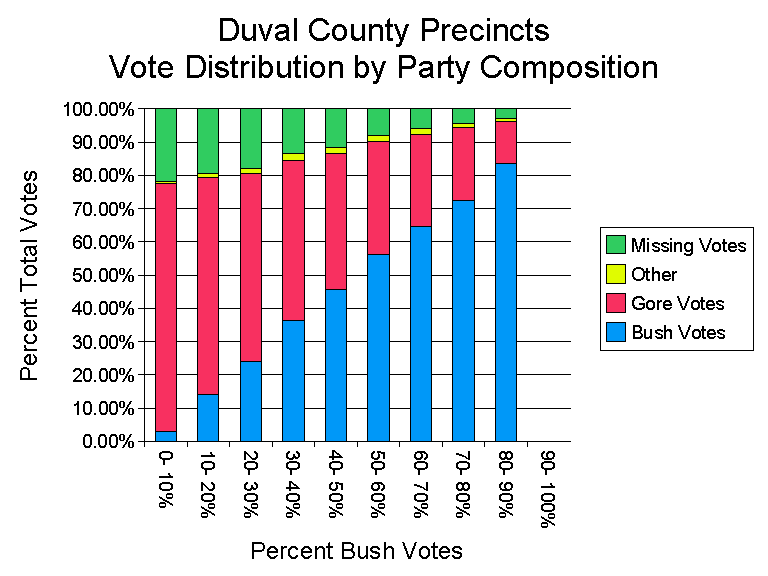
Range Voting can get unified third-party support (due to Nursery effect, they'd be crazy to support anything else).
| #candidates: | C=2 | 3 | 4 | 5 | 8 | 10 | 15 | 20 | 50 | 100 | 200 |
|---|---|---|---|---|---|---|---|---|---|---|---|
| 5123 voters | 100% | 73% | 61% | 52% | 38% | 32% | 24% | 19% | 8% | 4% | 2% |
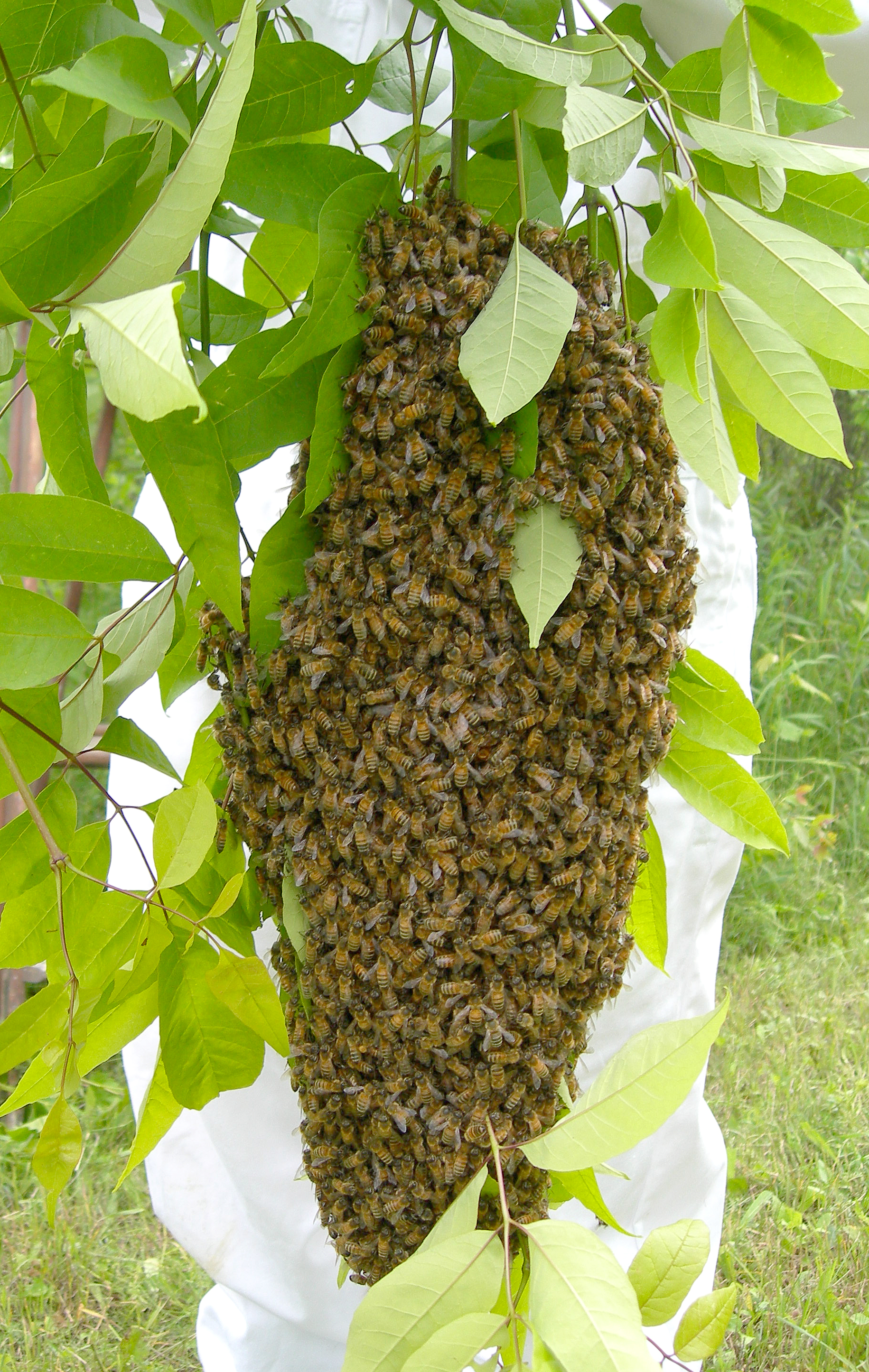


Honeybee (Apis Mellifera) swarms (each spring) and the 3mm-long eusocial ant Leptothorax Albipennis (after nest destruction) both use range voting to decide on the location of their new nest.
Problems bees face: Tiny brains. Can they do "addition," "division," and "averaging"? If so, can they communicate results reliably? What if some bees mentally defective or miscommunicate? How to reach a swarm-wide consensus? How to do it quickly?
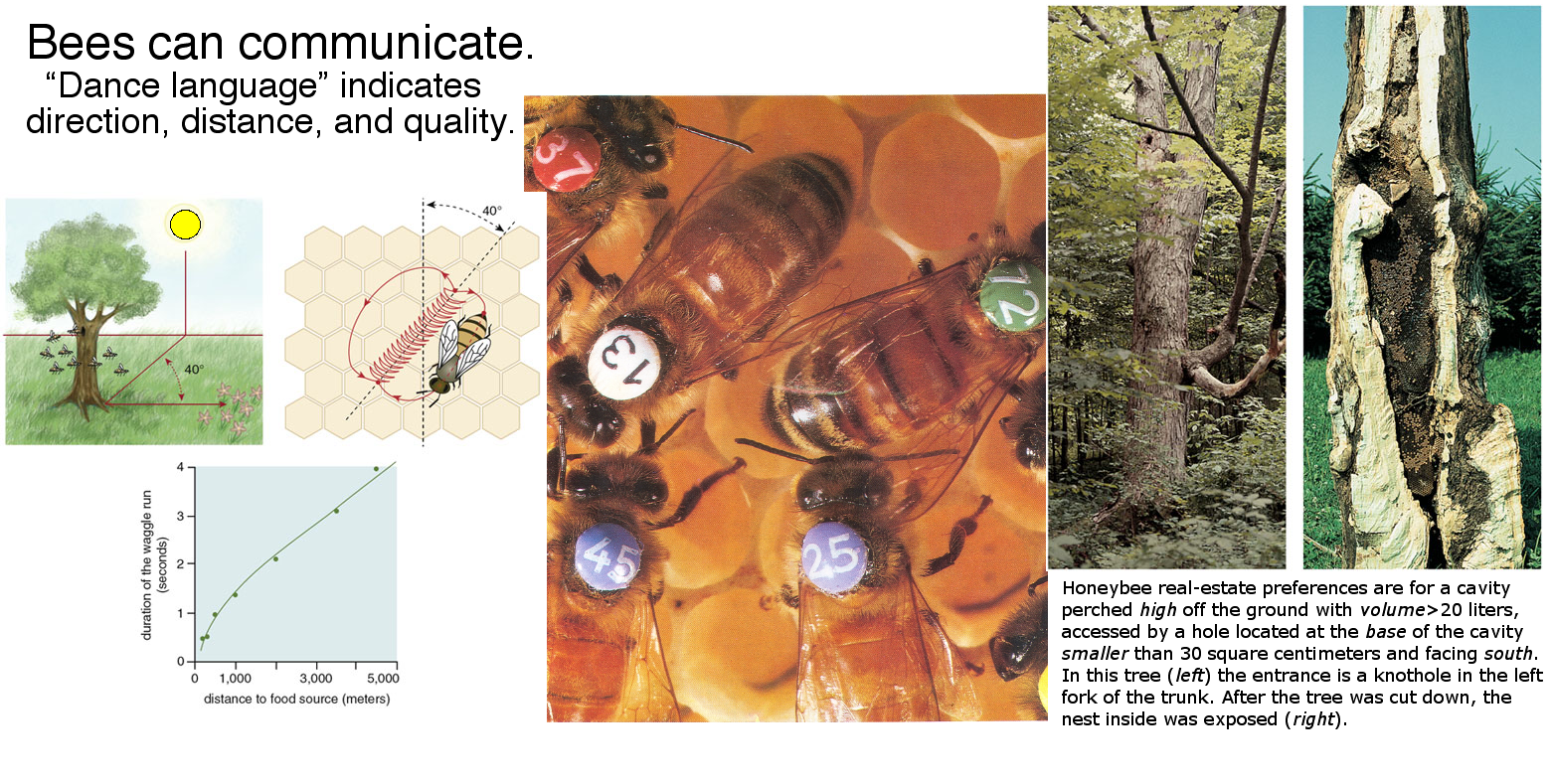
Problems bees face: Tiny brains. Can they do "addition," "division," and "averaging"? If so, can they communicate results reliably? What if some bees mentally defective or miscommunicate? How to reach a swarm-wide consensus? How to do it quickly? "Robust log-time parallel algorithm"...
How bees do it: (Robust log-time parallel algorithm!)
In the ∞-time limit, the "bank account" with the greatest "interest rate" wins, no matter who was richest at the beginning of the process. The interest (i.e. recruitment, i.e. faction-growth) rate in bee-elections is by design/definition proportional to its range-vote score.
∴ The range-voting winner is the faction which eventually dominates.
*(However, the bees do not have infinite time – only willing to wait about 1 week – and also since only a finite number of bees, there is statistical noise. These non-idealities could cause some other winner, if unlucky.)
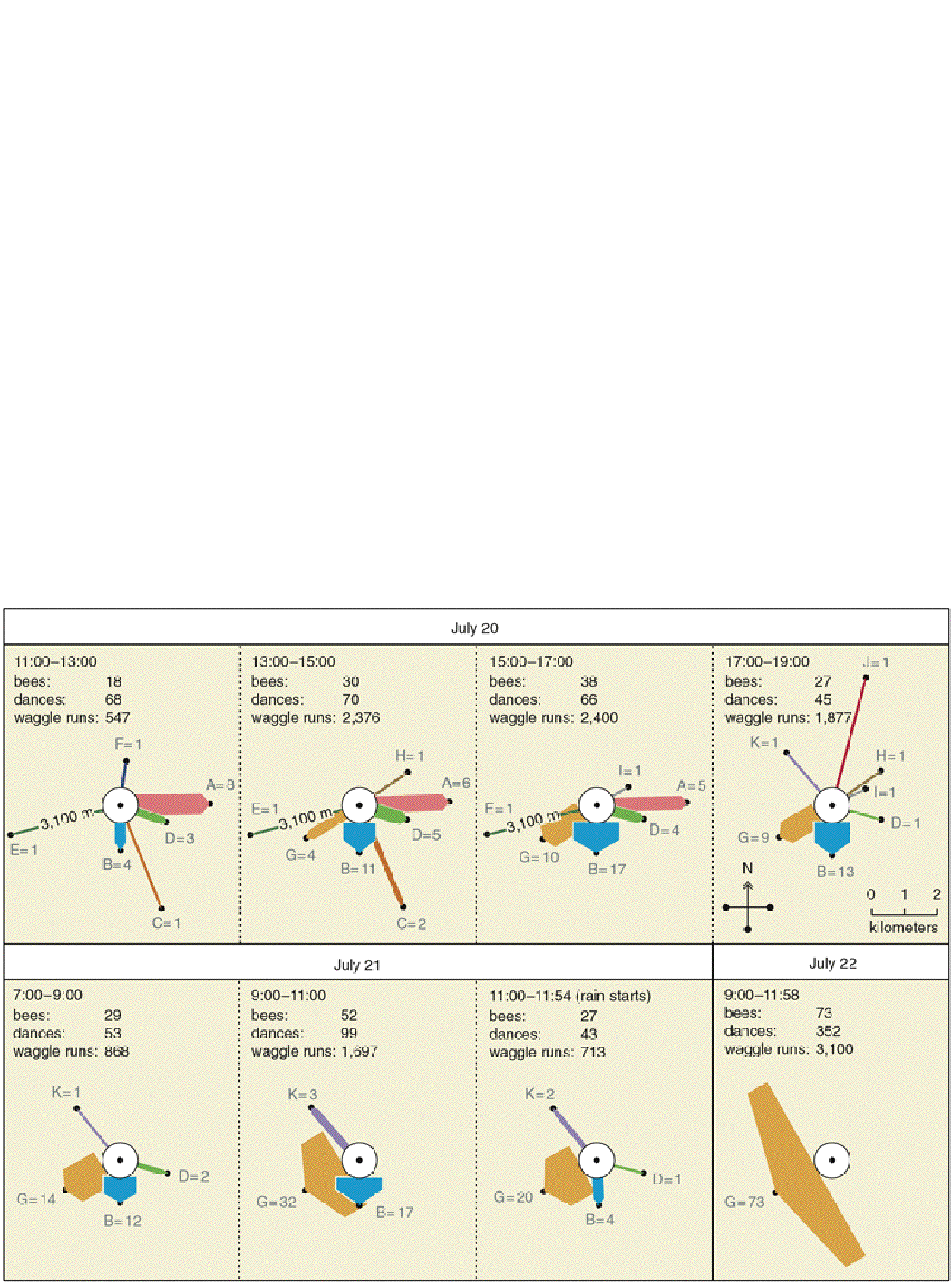
How good are they? Swarm: 2000-20000 bees. ≥1015 elections so far. Usually find ≈20 different housing options within about 100 km2, and ≈90% of the time, bee swarm succeeds in selecting (what appears to entomologists to be) best one.
Compare plurality-using humans: Computer sims ⇒ 1283 honest plurality-voters, given 10 choices (each voter regards each choice as worth standard-normal-random-number "dollar amount," all randoms generated independently before experiment begins) succeed in choosing the best (maximum ∑ dollars) 32% of the time.
Random guess: (10%),
Sim-humans employing "approval voting" (approving choices with value greater than midway between the best & worst available) then 54%.
Sim-humans employing "range voting" (scoring best choice 99, worst 0, rest linearly interpolated) then 79%... at least approaching bee-quality.
Ants: The most successful macroscopic land animals (15-20% of all land animal biomass?!). 200 Myr old.
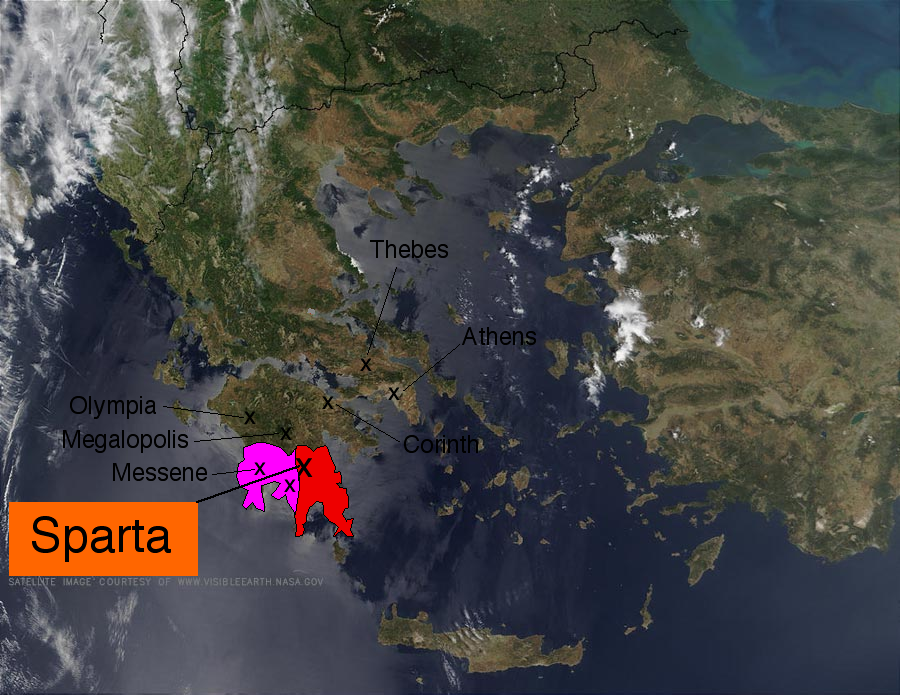
|
|
"[The Spartans'] unique constitution cannot be placed under any general head; cannot be called kingdom, oligarchy, or democracy, without misleading... it participated in all three." — J.B.Bury (quote p.118).
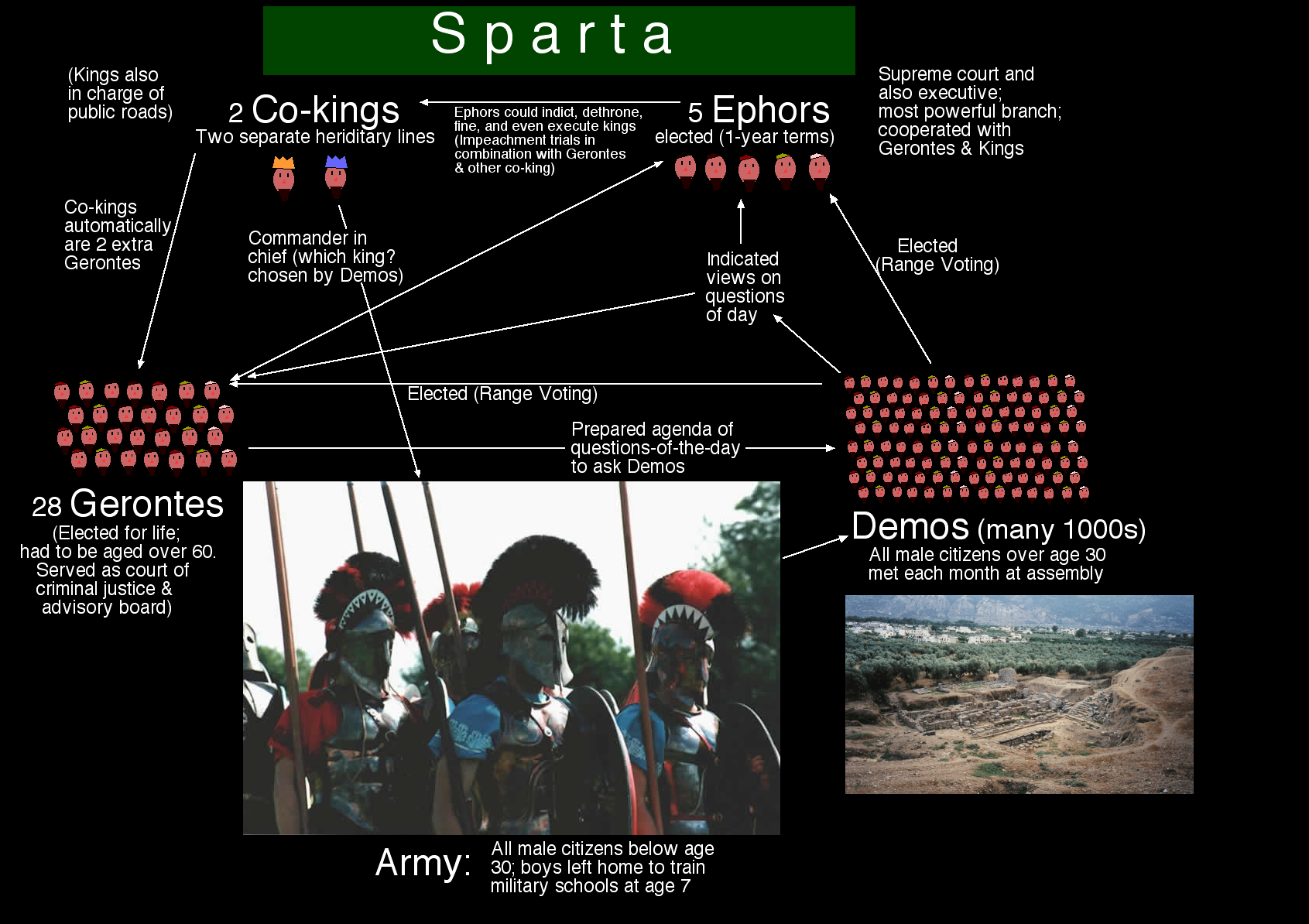
Sparta at its peak was the most powerful state in Greece, hence world. Both the earliest, and longest-lasting, government with substantial democratic component ever (somewhere between 580 and 1040 years):

|
Sparta's solution: (Aristotle called it "childish")

Venice was the most-democratic country of its age, and at its peak the richest biggest-trading city, with the greatest navy. It had the second-longest-lasting government with substantial democratic component ever:

Her unique system of government... was stern, occasionally even harsh... but [overall it had a] better record of fairness and justice than any other [European government]. – J. Norwich (introduction to A history of Venice)
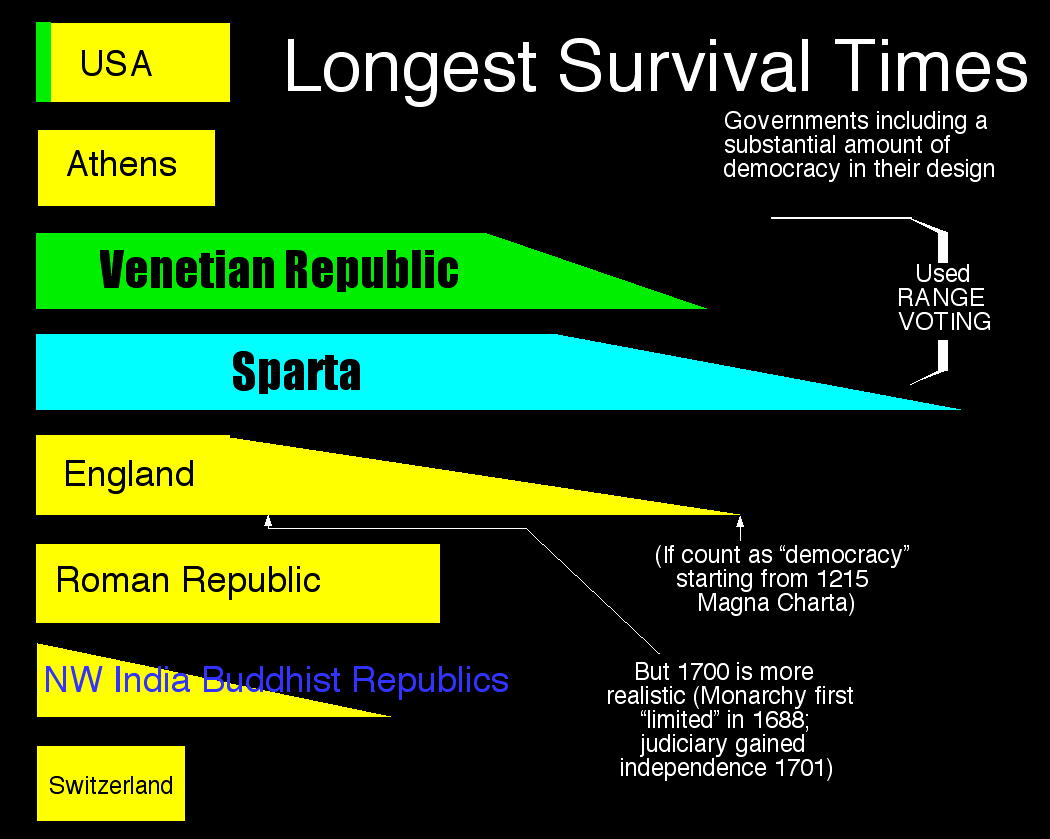
Approval voting used in 1987 USSR democratization experiment by M.S.Gorbachev: 5% of all USSR's 50,000 villages, towns, cities, and counties. (But USSR collapsed few years later.)
Essentially Approval voting used in early USA to elect President. [≤2 approvals; 2nd-placer wins vice-presidency.]
Ireland 1990, Australia 2007, France 2007, more.
CLONING+FB THEOREM (WDS 2007): Every reasonable(*) voting method based on rank-order votes is vulnerable either to candidate cloning or to favorite-betrayal. But range voting has neither defect.
(*) "Reasonable" = No "dictator," symmetric under candidate renaming, deterministic aside from tiebreaks which (if any) are random equally likely.
Does range voting maximize happiness? No (unfortunately). What does it maximize?
MAX-PLEASANT SURPRISE THEOREM (Ossipoff; proof trivial): Strategic Range (if that means Approval-style) voting maximizes (under reasonable assumptions) the number of "pleasantly surprised" voters and minimizes the number "unpleasantly surprised."
The reasonable assumption: strategic voters estimated expected utility (for them) E of the winner, then "approve" candidates above E.
"Surprise" is "pleasant" if winner has utility above expectation.
CONDORCET THEOREM (WDS, easy): Strategic Range (Approval) voting yields (under reasonable assumptions) a "Condorcet winner" whenever one exists.
The reasonable assumption: Approval voters act according to the following strategy: they order the candidates from best-to-worst, then select a "threshold" T, and they approve the candidates above T. They choose T to cause their vote to have the most impact.
The precise claim: Let N≥2. There does not exist an N-candidate tie-free election in which the Approval (A) and Condorcet (C) winners differ, provided that, if they were going to differ (A≠C) that all the approval voters would place their threshold T strategically under the assumption the winner was going to be either A or C, i.e. would place T somewhere between them.
Proof: Assume for a contradiction that A≠C. Then the approval voters will strategically place their thresholds between C and A. But that will cause C to be approved more times than A is approved (since C, being the Condorcet winner, is preferred over A by a majority). Hence the claim A was the Approval winner and A≠C, leads to a contradiction. Hence either A=C or there is no Condorcet winner C. Q.E.D.
Interpretation: Range does as well as Condorcet if strategic voters (actually can yield CWs more often) and better if honest voters.
DHILLON+MERTENS (1999) THEOREM: Normalized Range Voting ("normalized" meaning that every voter scores her favorite with the maximum allowable score and her most-hated candidate with the minimum) is the unique voting system (in situations with at least 3 voters and at least 5 candidates) obeying the following Arrow-like axioms:
Define "semi-honesty":
Your true feeling: A>B>C. Semi-honest: A=B>C. Lying: B>A.
Better name: limit honesty.
Extended Gibbard-Satterthwaite theorem: With range voting
Examples of 4-candidate range-voting elections where strategically-best vote is to lie (not even semi-honest).
Examples where best strategy in range voting is not "approval style" – when is it?
Honesty is not a bad strategy in range voting (computer experiments) hence Clay Shentrup argues, in view of the considerable difficulty of computing optimum-strategy range votes (he explains how) thos enaive people who just vote honestly may actually not be very "victimized"?
Analysis of how good various voting strategies are in 3-candidate range voting election – quite subtle
Benham's nasty anti-range example where strategists cause a social problem.
Strategic+Honest voter mix experiments with range voting; also victimization experiments
- (& responses)
OPTIMALITY THEOREMS (WDS 2008): In a breakthrough, II, III, developed methodology for determining the exact best rank-order, and best range-style-ballot voting system (i.e. minimizing Bayesian Regret under some utility & voter-behavior models). Under the RNEM ("random normal elections model") the best rank-order ballot voting system for 3-candidate elections is Borda. Range and Approval both are superior to Borda for any mixture of honest and strategic voters in 3-candidate elections.
Sketch of Proof methods:
Acquire votes. Find canddt (conditioned on those votes) with greatest expected utility based on historical memory. Elect him.
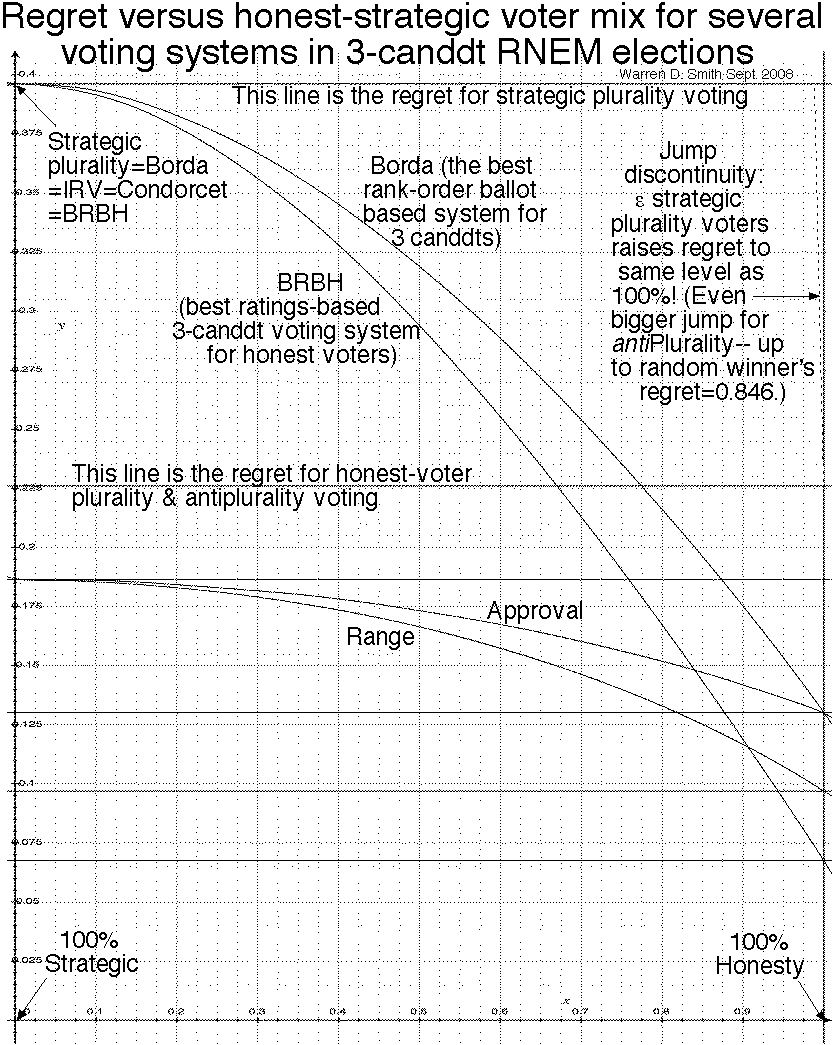
Interval arithmetic:
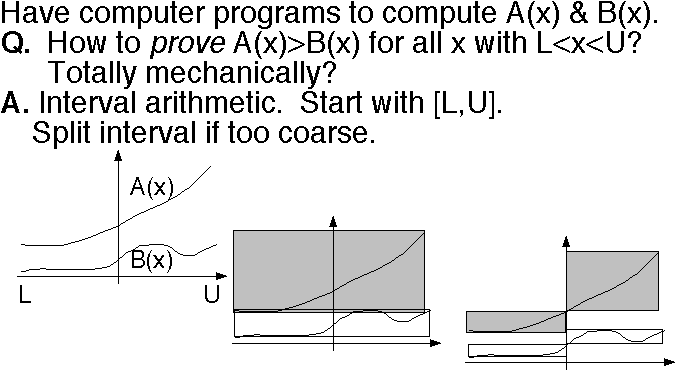
Works if A(x), B(x) have exact formulas. Also works for programs involving numerical integration, if know easy "derivative bounds" and "tail bounds" bounding numerical ∫≈&sum error.
| Voting method | "Wrong winner" percentage | V-1/2Regret |
|---|---|---|
| Magic Best | 0 | 0 |
| BRBH=Best ratings-based (Honest voters, see sec. 6) | 18.70338(6)% | 0.0674537(2) |
| Honest Range | 22.35938(6)% | 0.0968636(3) |
| Honest Approval (mean as threshold) | 25.86333(3)% | 0.1300873(4) |
| Best rank-order-based (Honest Voters)=Borda | 25.86335(4)% | 0.1300876(2) |
| Strategic Approval (=Range, see theorem 13) | 30.98197(3)% | 0.1863856(2) |
| Honest Plurality=AntiPlurality | 33.99984(3)% | 0.2260388(4) |
| Magic best among the 2 frontrunners only | 1/3≈33.3333333% | |
| Strategic Plurality (=Borda=IRV=Condorcet=BRBH, see theorems 8 & 13) | 45.43326(5)% | (3/2)π-1/2-21/2/π≈0.3961262173 |
| Random winner=Strategic AntiPlurality | 2/3≈66.6666667% | (3/2)π-1/2≈0.8462843754 |
| Worst winner | 100% | 3π-1/2≈1.6925687506 |
Core idea behind proof: "Don Saari's planar geometrical picture."
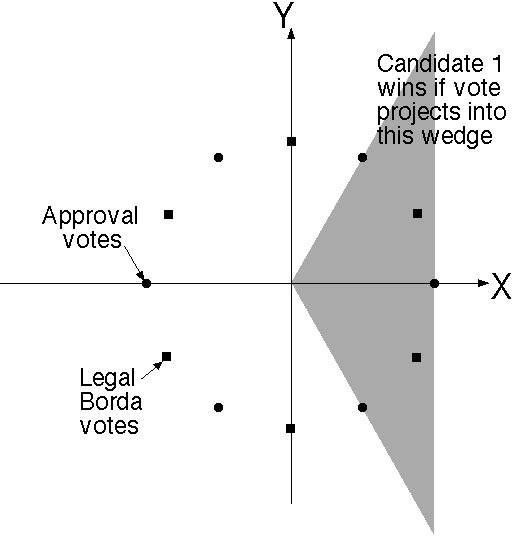
Although 3-candidate Borda and Approval votes v seem 3-dimensional, really only 2D because OK to project into plane v1+v2+v3=0.
In this plane, the 6=3! allowed Borda votes
are vertices of a regular hexagon. (Non-Borda weighted positional systems ⇒ irregular hexagons.)
The 6=23-2 non-silly approval votes (rescaled and translated to lie on the v1+v2+v3=0 plane)
also vertices of regular hexagon.
Up to a scaling by a factor of √3 (which cannot matter) and rotation by 30 degrees: same hexagon!
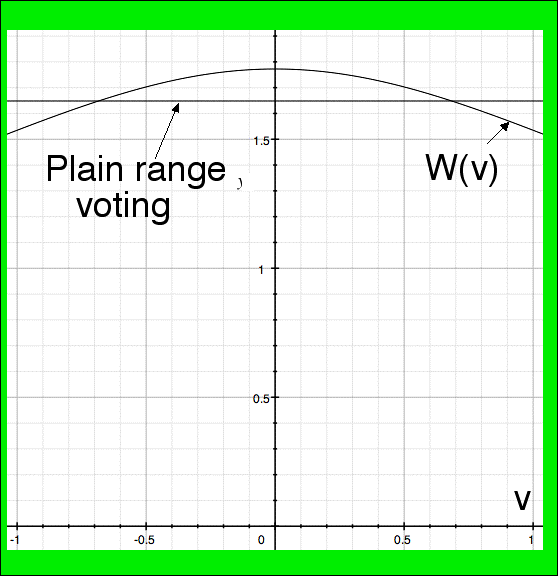
THEOREM I.12: It's range voting ("honest" means rate favorite +1, worst -1, others linearly interpolated between based on utility) except that votes (-1, v, 1) are multiplicatively weighted by W(v) and then the candidate with the greatest weighted ∑score wins. Magic optimal weighting function:
| line # | #Canddts→ ↓Voting Method | N=4 | N=5 | N=6 | N=7 | N=8 | N=9 | N=31 |
|---|---|---|---|---|---|---|---|---|
| 1 | Magic Best | 0%, 0 | 0%, 0 | 0%, 0 | 0%, 0 | 0%, 0 | 0%, 0 | 0%, 0 |
| 2 | Honest Range | 22.50%, 0.08299 | 22.28%, 0.0731 | 21.97%, 0.0657 | 21.67%, 0.0602 | 21.38%, 0.0559 | 21.10%, 0.0523 | 18.13%, 0.0279 |
| 3 | Honest Best Ranked | 27.83%, 0.1289 | 28.64%, 0.1236 | 28.93%, 0.1174 | 28.96%, 0.1113 | 28.86%, 0.1057 | 28.69%, 0.1005 | 23.90%, 0.0504 |
| 4 | Honest Borda | 27.91%, 0.1297 | 28.85%, 0.1255 | 29.32%, 0.1207 | 29.55%, 0.1161 | 29.67%, 0.1120 | 29.71%, 0.1083 | 29.31%, 0.0786 |
| 5 | Honest Strat-Best-Ranked | 30.44%, 0.1553 | 33.92%, 0.1767 | 36.05%, 0.1879 | 37.35%, 0.1925 | 39.03%, 0.2033 | 40.73%, 0.2159 | 52.88%, 0.3052 |
| 6 | Mean-Thresh Approval | 31.75%, 0.1695 | 35.96%, 0.2000 | 39.15%, 0.2245 | 41.65%, 0.2444 | 43.70%, 0.2613 | 45.41%, 0.2756 | 59.28%, 0.4060 |
| 7 | Strategic Approval=Range | 37.25%, 0.2357 | 41.59%, 0.2728 | 44.79%, 0.3016 | 44.26%, 0.3244 | 49.22%, 0.3429 | 50.81%, 0.3578 | 62.41%, 0.4674 |
| 8 | Honest Top-2 | 37.60%, 0.2411 | 42.30%, 0.2829 | 46.73%, 0.3303 | 50.67%, 0.3780 | 54.10%, 0.4238 | 57.12%, 0.4675 | 82.67%, 1.0440 |
| 9 | Honest Plurality | 43.24%, 0.3230 | 50.05%, 0.4069 | 55.30%, 0.4804 | 59.51%, 0.5460 | 62.96%, 0.6046 | 65.85%, 0.6580 | 87.43%, 1.2717 |
| 10 | Best Semi-Strategic (Top-2) | 46.44%, 0.3928 | ||||||
| 11 | Magic Best-Of-2 | 50.00%, 0.4652 | 60.00%, 0.5988 | 66.67%, 0.7030 | 71.43%, 0.7880 | 75.00%, 0.8594 | 77.78%, 0.9208 | 93.55%, 1.4923 |
| 12 | Strategic PsuBest Ranked | 53.10%, 0.5096 | 56.81%, 0.5481 | 59.2%, 0.569 | 60.85%, 0.5806 | 61.94%, 0.5861 | 62.74%, 0.5878 | 68.27%, 0.5836 |
| 13 | Strategic Top-2 | 53.12%, 0.5273 | ||||||
| 14 | Strategic Borda | 54.33%, 0.5201 | 58.69%, 0.5716 | 61.44%, 0.6005 | 63.42%, 0.6201 | 64.95%, 0.6350 | 66.22%, 0.6677 | 76.41%, 0.7809 |
| 15 | Strategic Hon-Best-Rnkd | 54.70%, 0.5248 | 59.42%, 0.5835 | 62.49%, 0.6199 | 64.73%, 0.6465 | 66.52%, 0.6686 | 68.02%, 0.6880 | 80.30%, 0.9089 |
| 16 | Strategic Plurality | 58.25%, 0.5792 | 66.11%, 0.7128 | 71.43%, 0.8170 | 75.29%, 0.9020 | 78.21%, 0.9734 | 80.51%, 1.0349 | 94.03%, 1.6062 |
| 17 | Random Winner | 75.00%, 1.0294 | 80.00%, 1.1623 | 83.33%, 1.2672 | 85.71%, 1.3522 | 87.50%, 1.4236 | 88.89%, 1.4850 | 96.77%, 2.0565 |
| 18 | Magic Worst | 100.0%, 2.0588 | 100.0%, 2.3259 | 100.0%, 2.5344 | 100.0%, 2.7043 | 100.0%, 2.8472 | 100.0%, 2.9700 | 100.0%, 4.1129 |
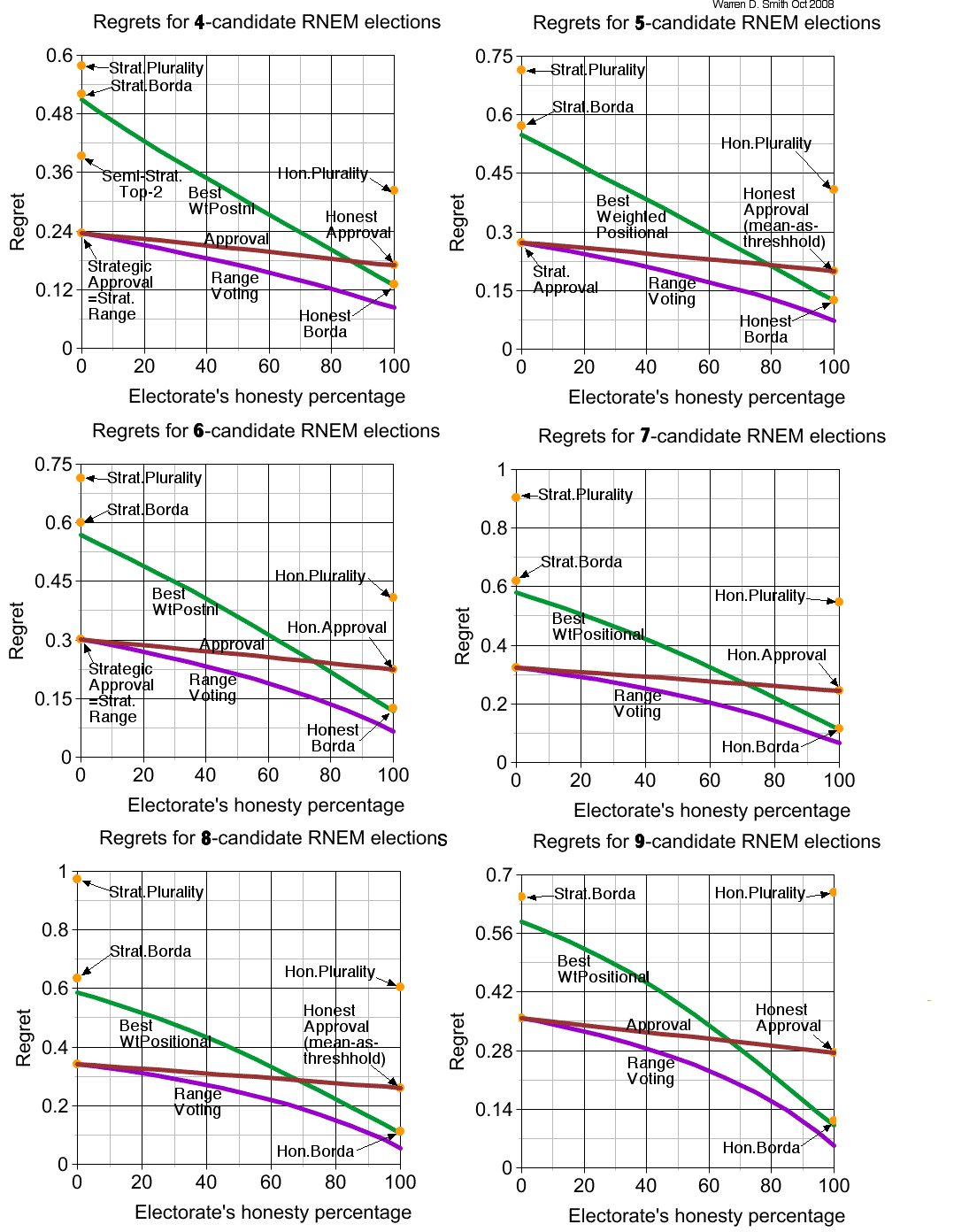
"God" (or Gallup) pre-announces ordering of candidates in decreasing order of a priori election chances. Each voter gives max-permissible vote to the best among the 2 frontrunners, min-permissible to other, then going down the order gives each canddt max or min depending on whether utility > or < mean(utility of preceding canddts).
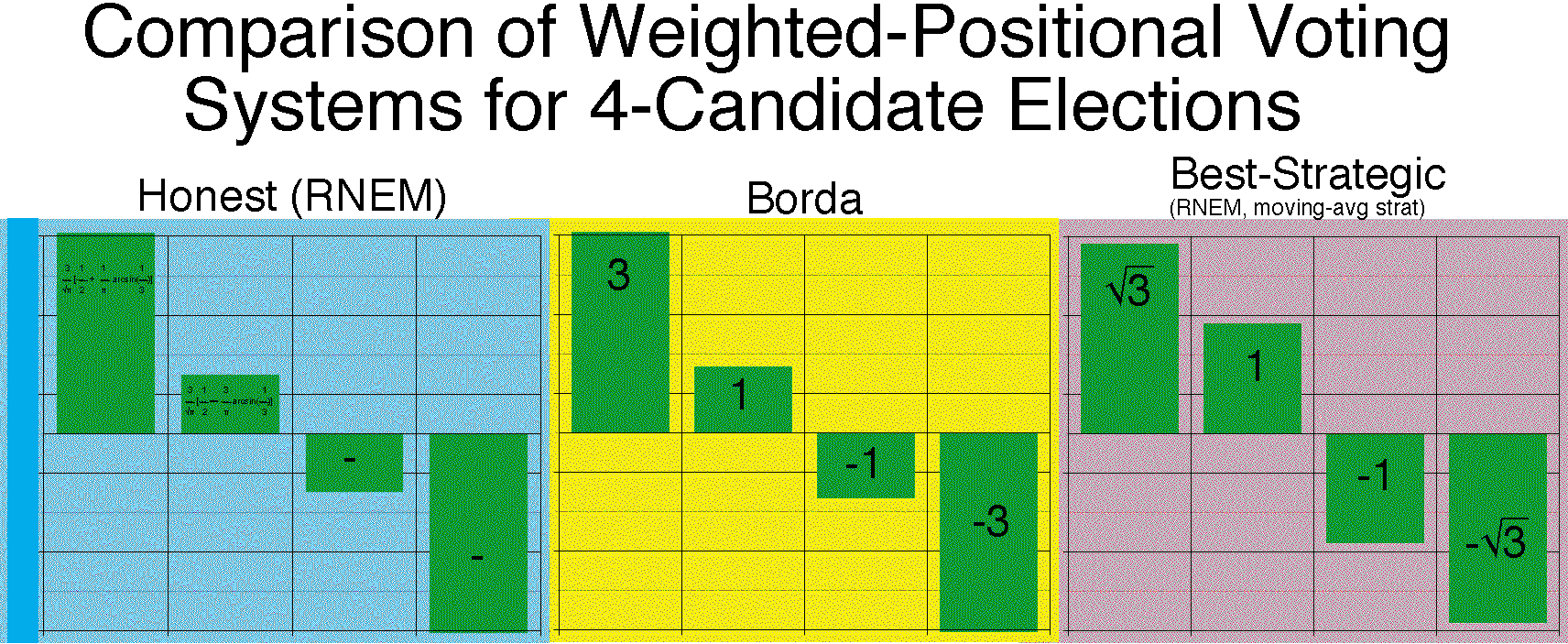
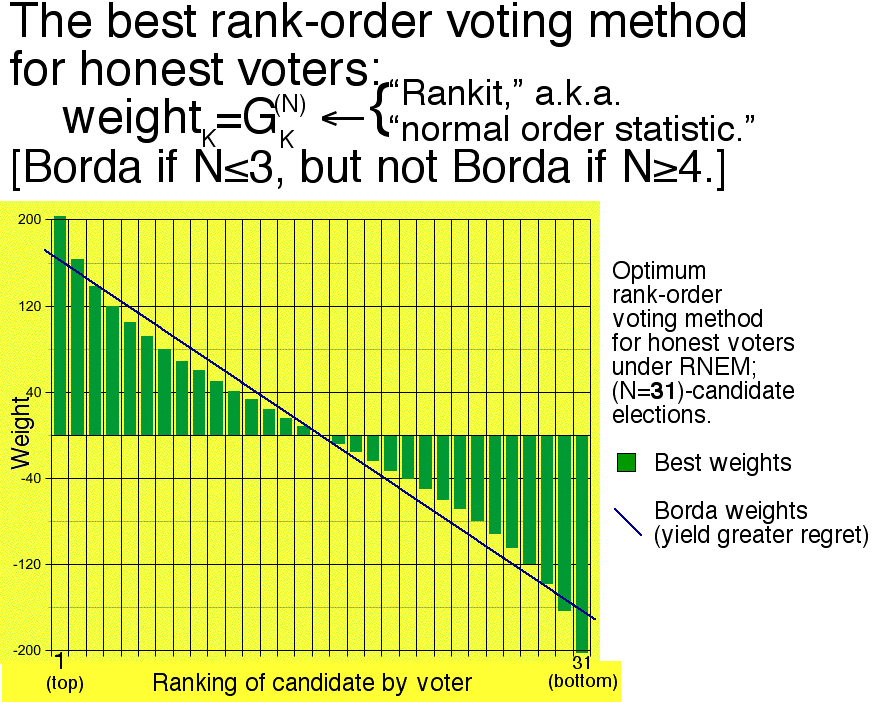
|
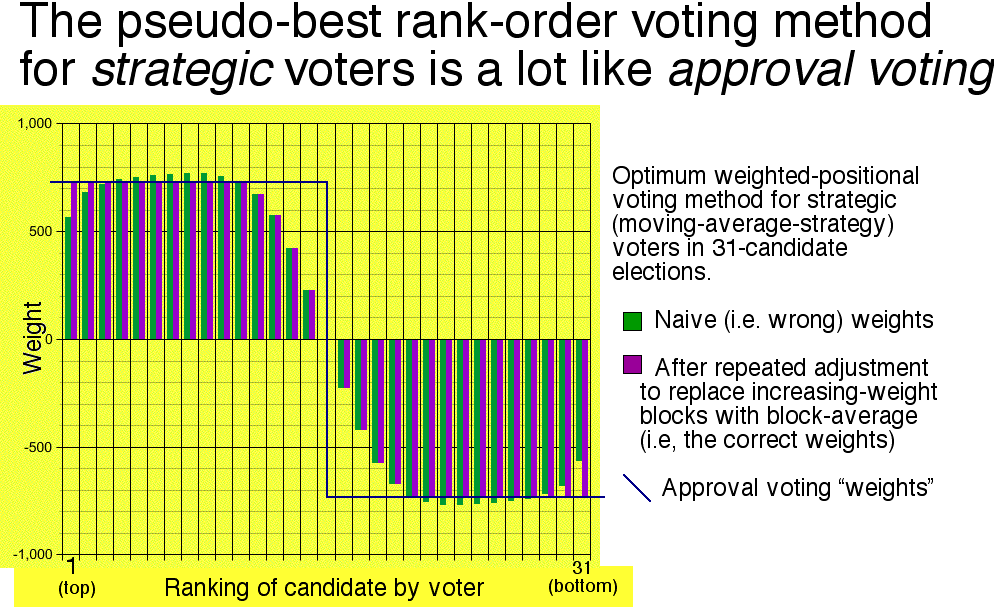
|
Ultra-simple mildly-realistic model (generalizes "impartial culture"): "All elections equally likely."
as the utility of electing that candidate for that voter.
Integral over all NV-dimensional space. "Election winner" depends on the rules of the election method E (saying how "winner" determined from "votes") and the voter-behavior model M saying how voters generate their votes from their utilities.
In RNEM, the best rank-order system is weighted-positional with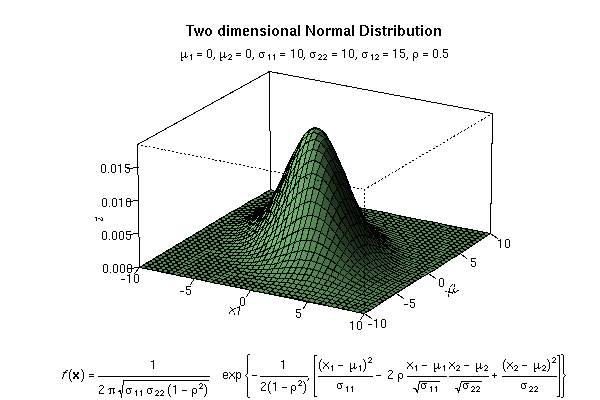
The correlation-based method for finding BR(E):
How to do these N- and 2N-dimensional integrals?
THEOREM: Any N-dimensional multiple integral with
Can be expressed in closed form. Formula may involve
matrix-stuff, square-roots, exp(z), ln(z), trig(z), arctrig(z), Li2(z), Li3(z).
PROOF SKETCH:
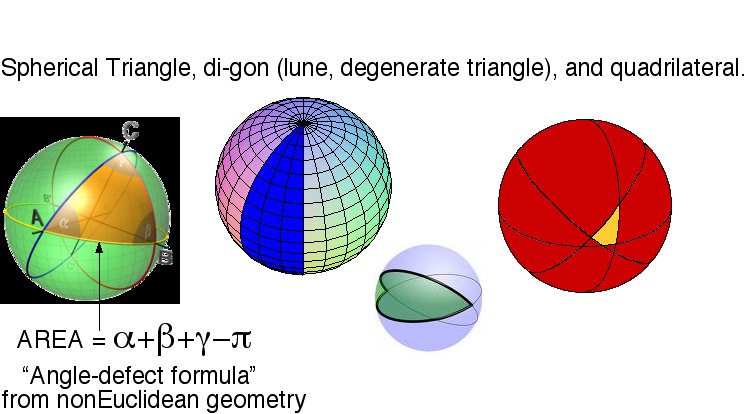
|

|
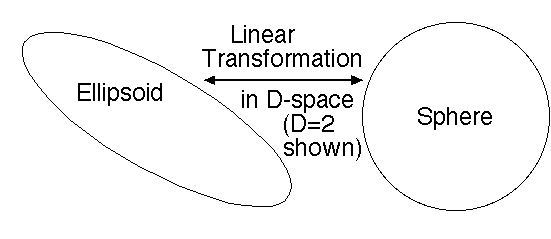
|
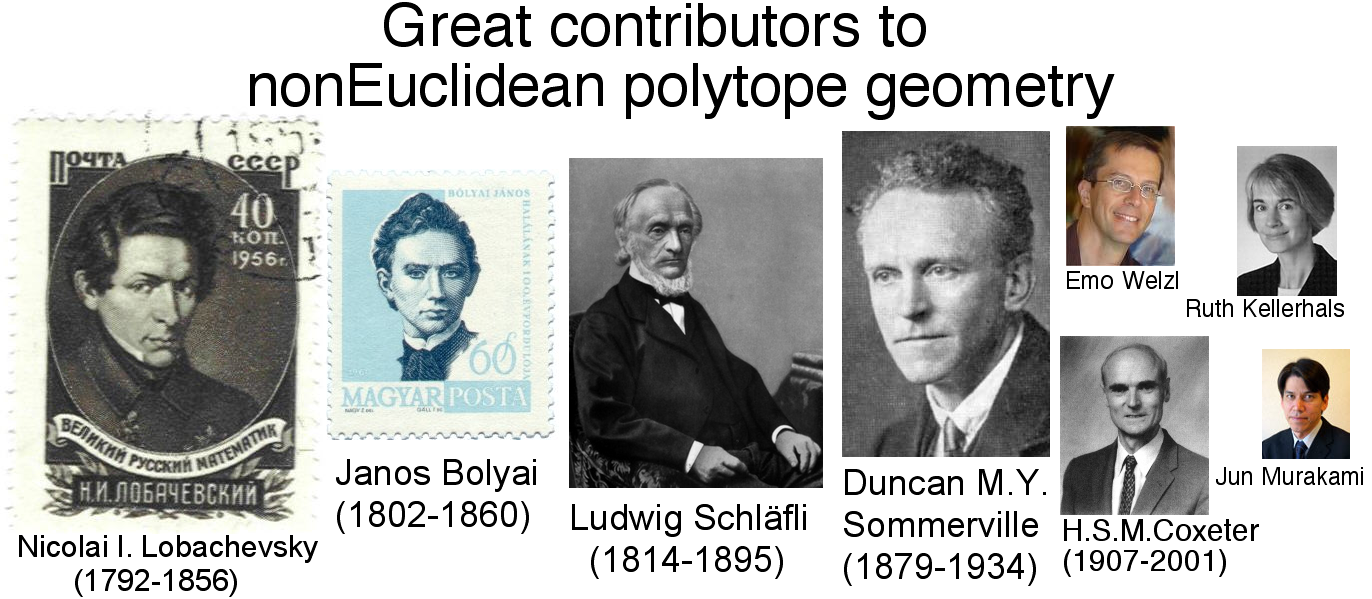
Good news: hlinked to my paper is world's first computer program to output Schläfli fn closed forms for N≤5.
Bad news:
The formulas get exponentially hairy when N large:
N=4 ⇒ Murakami formula 1 page long.
N=7 ⇒ perhaps 500,000 pages (estim.) when fully expanded
Definition:
Formula as 1-dimensional integral:
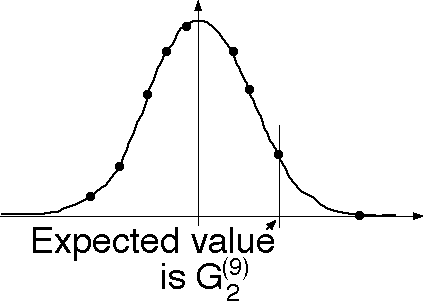
where
F'(y)=(2π)-1/2exp(-y2/2) is the standard normal density;
F(x)=[1+erf(2-1/2x)]/2 is the CDF of (i.e. integral dy from -∞ to x of) the standard normal density;
[Formula valid for any probability density F'(y), not just normal,
arises since
kth smallest of N i.i.d. random deviates has F(y) that is
By symmetry:
Of particular interest: G1(N) = expected value of maximum of N independent standard normal deviates:
Only need the G1(N) because all other Gk(N) can be computed in terms of them alone, via (Federer 1951) recurrence
| N | G1(N) | N | G1(N) |
|---|---|---|---|
| 1 | 0 | 11 | 1.58643635190800 |
| 2 | π-1/2≈0.56418958354775 | 12 | 1.62922763987191 |
| 3 | (3/2)π-1/2≈0.84628437532163 | 13 | 1.66799017704913 |
| 4 | 3π-1/2[1/2+π-1arcsin(1/3)]≈1.02937537300396 | 14 | 1.70338155409998 |
| 5 | (5/2)π-1/2[1/2+(3/π)arcsin(1/3)]≈1.16296447364052 | 15 | 1.73591344494104 |
| 6 | 1.26720636061147 | 16 | 1.76599139305479 |
| 7 | 1.35217837560690 | 17 | 1.79394198088269 |
| 8 | 1.42360030604528 | 18 | 1.82003187896872 |
| 9 | 1.48501316220924 | 19 | 1.84448151160382 |
| 10 | 1.53875273083517 | 20 | 1.86747505979832 |
| 200 | 2.74604244745115 | 2000 | 3.435337162 |
| 20000 | 4.01878926 | 200000 | 4.53333091 |
Previous authors found closed forms for Gk(N) when N≤5. Using our Schläfli function and moment theory we know closed formulas also exist for all the G(6), and G(7) (involving dilogs); and if also allow trilogs then closed forms exist for all the G(8) and G(9) too. [But the G1(6) formula is about 4 pages long!]
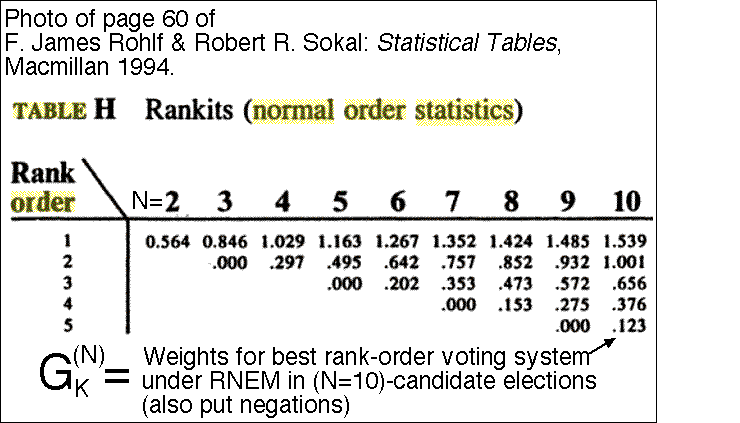
Let P(x)=F'(x)=(2π)-1/2exp(-x2/2) be the standard normal density function. Then:
Weighted-positional voting system, N-candidate election, defined by N "weights" W1≥W2≥...≥WN. We "standardize" so mean-weight=0 and mean-square-weight=1.
LEMMA (WPV correlations 1): The voteivotej correlation in the RNEM is
LEMMA (WPV correlations 2): The voteiutilityj correlations in the RNEM obey
Reversing the order of, and negating, the weights in a (standardized) weighted positional voting system, yields the same vote-utility (and vote-vote) correlations as for the original voting system; and hence the same wrong-winner probabilities and BR values arise in the V→∞ limit (for any fixed number N of candidates, under RNEM).
Example: AntiPlurality and Plurality voting have the same regrets and same wrong-winner probabilities in the V→∞ limit. But (apparently) for any finite #voters V, AntiPlurality does worse (by both measures)!
Definition:
Optimal/Pessimal Theorem:
| candidate | votes | candidate | votes |
|---|---|---|---|
| YYYY | 0 | YNYY | 4 |
| YYYN | 4 | YNYN | 1 |
| YYNY | 4 | YNNY | 1 |
| YYNN | 1 | YNNN | 1 |
| NYYY | 4 | NNYY | 1 |
| NYYN | 1 | NNYN | 1 |
| NYNY | 1 | NNNY | 1 |
| NYNN | 1 | NNNN | 5 |
Contrived worst-case voter-distributions attackable as unrealistic "cherry=picking."
∴ Examine random voters:
Range=Optimal & Others=Worse Theorem:
(In all these cases, get significant regret.)
Conjecture: Prob(no Condorcet winner exists)→1 so the question for Condorcet methods depends entirely on their "backup" method invoked when no CW.
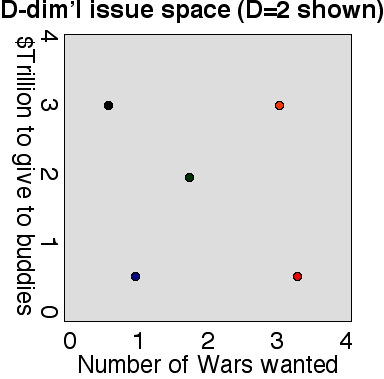
Definition:
Condorcet=Optimal (in V→∞ limit) & Others=Not Theorem:
Proof:
1A & 1B: Steal results of Davis, de Groot, Hinich 1972 + some probability theory.
1C & 2: Steal Fourier result of Beckner 1975.
3: Example for IRV: Place three candidates at -0.01, 0, +0.01
and voters distributed standard normal on real line.
-------------X----------------------0-----------------------X-------------
---------------X-X------------------0-----------------------X-------------
But: L1 distance, utilities based on dot products not distance, or voter-distrib arbitrarily-slightly aspherical ⇒ RV can be (& usually is) better than Condorcet.
Yee diagrams: Thm shows Condorcet methods ⇒ "Voronoi Diagram."